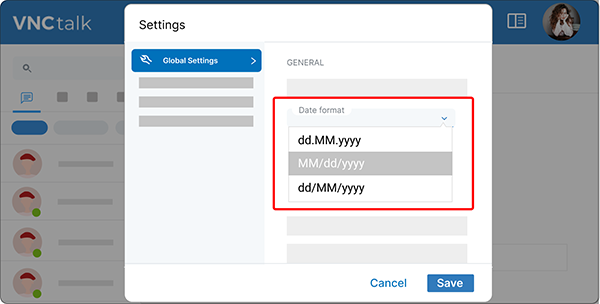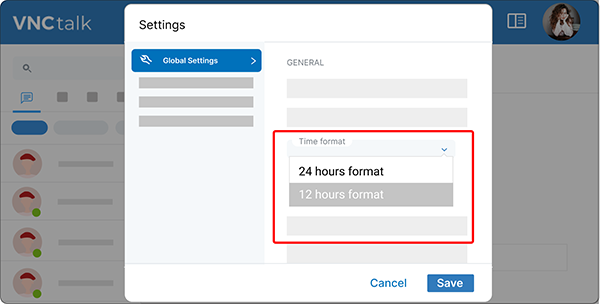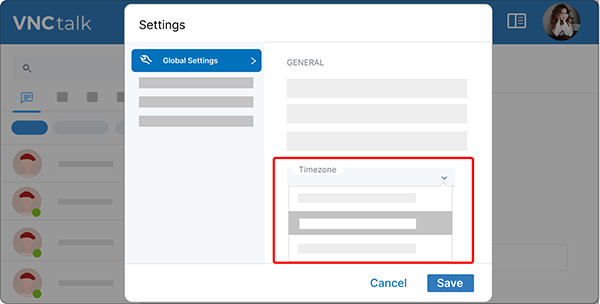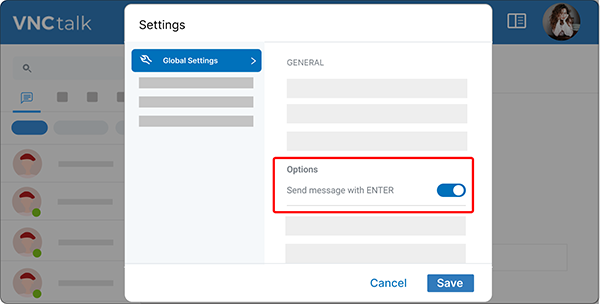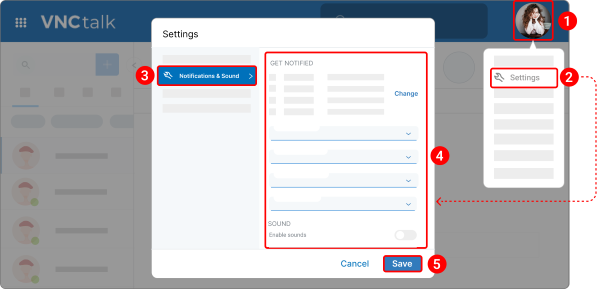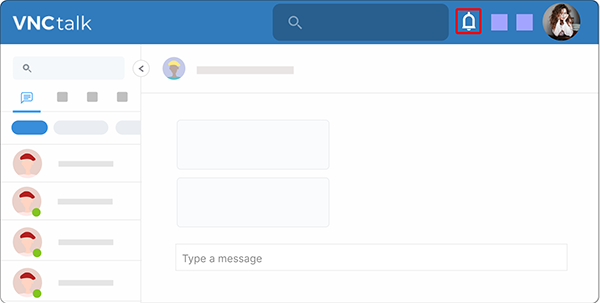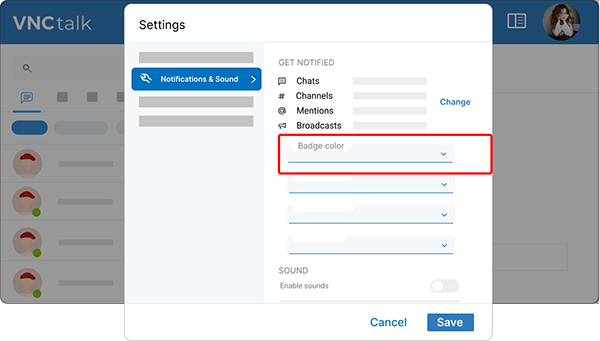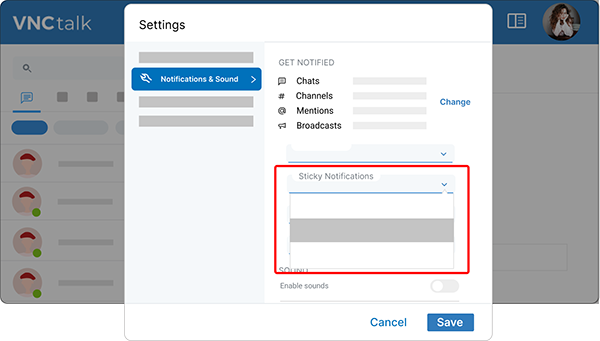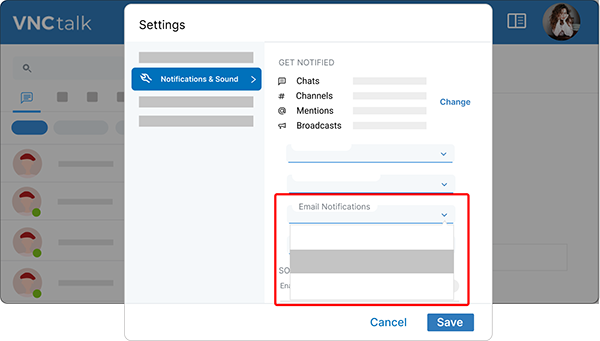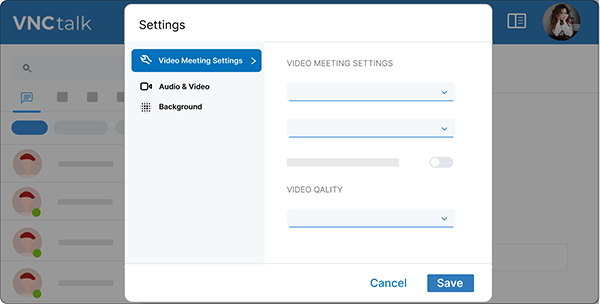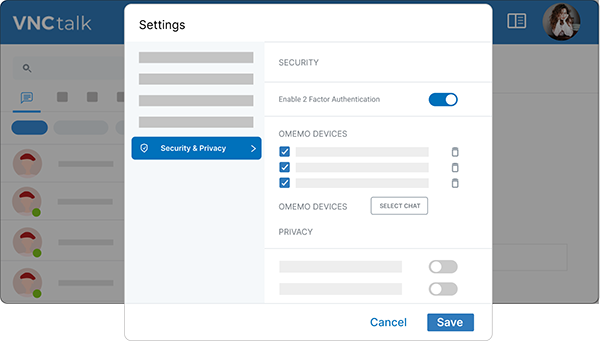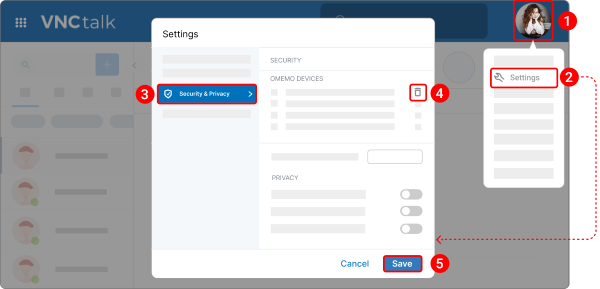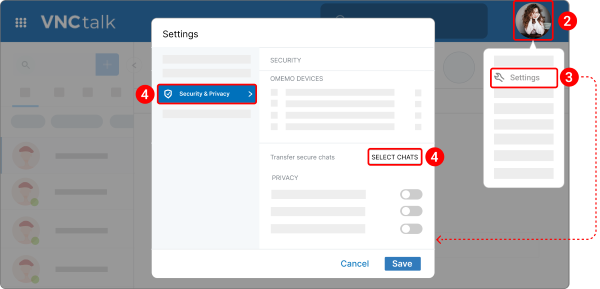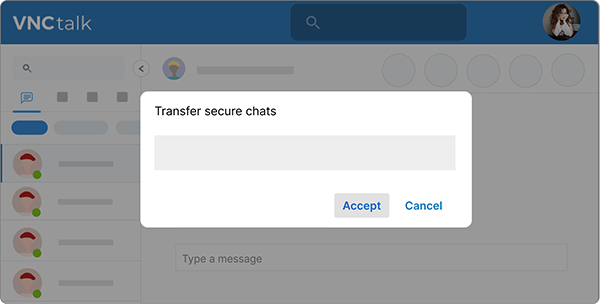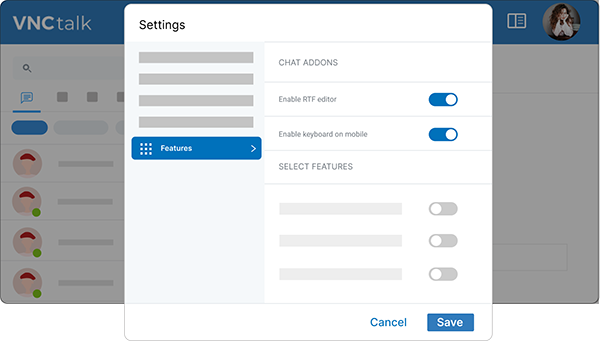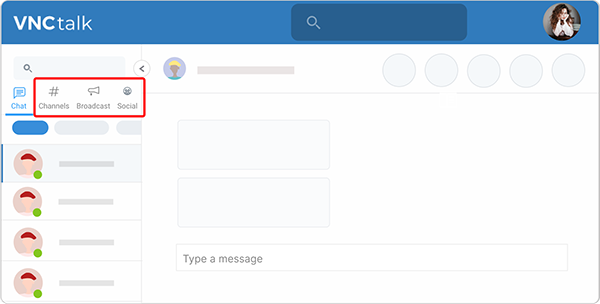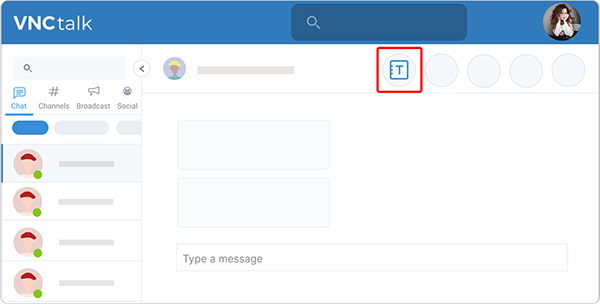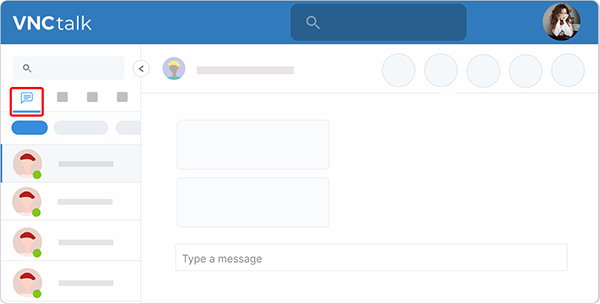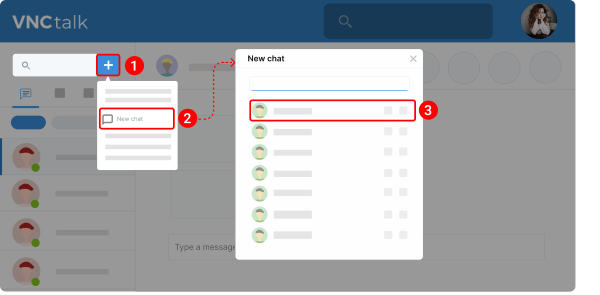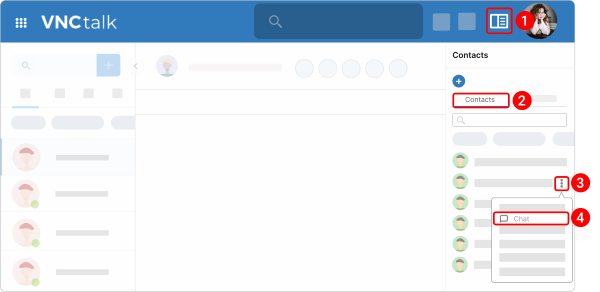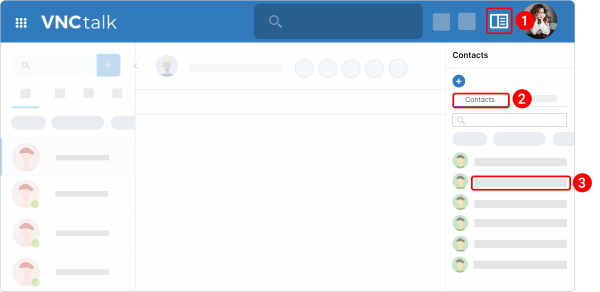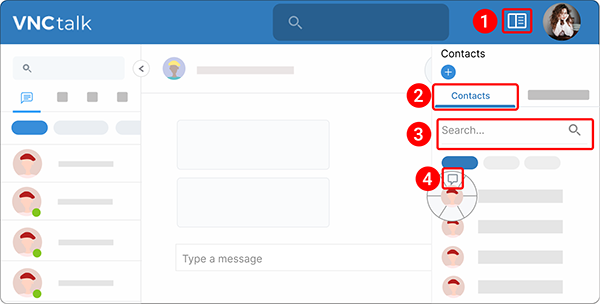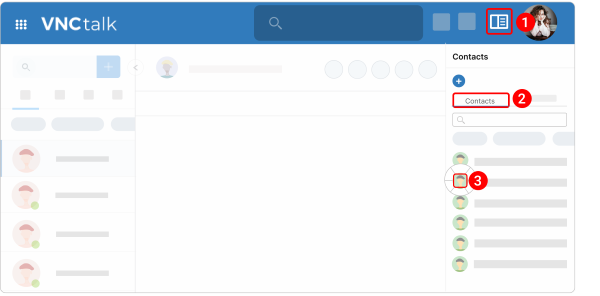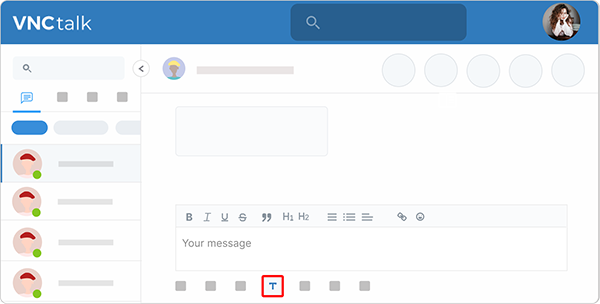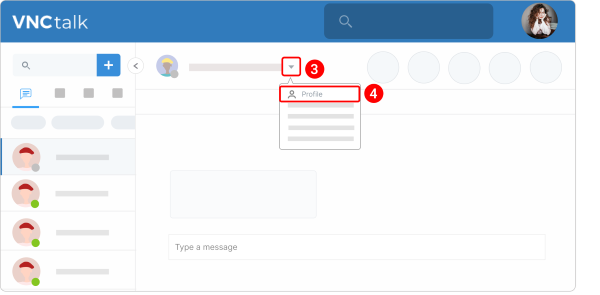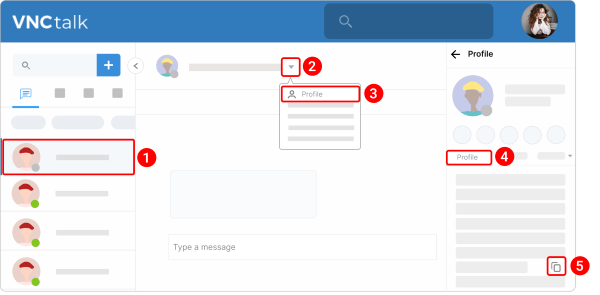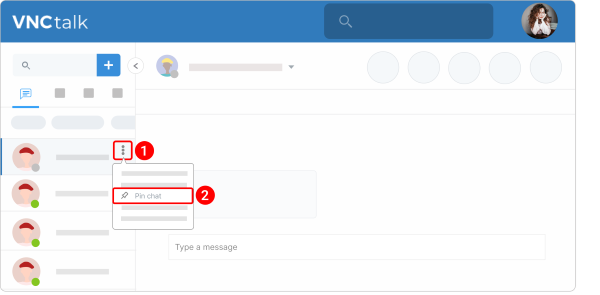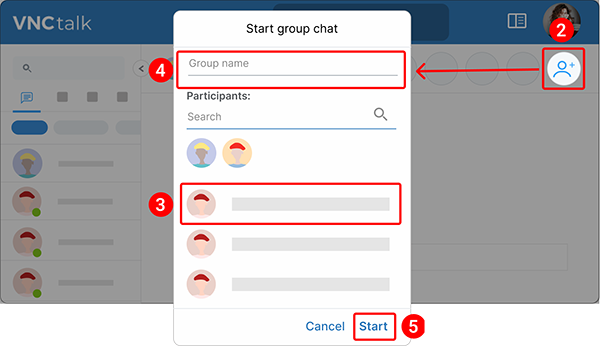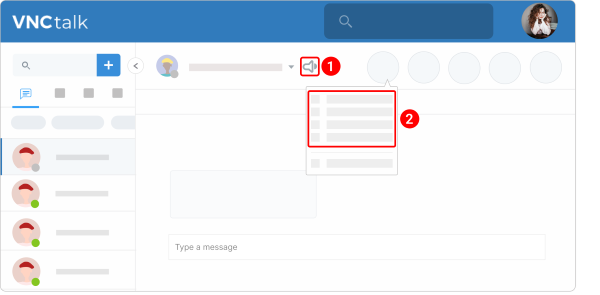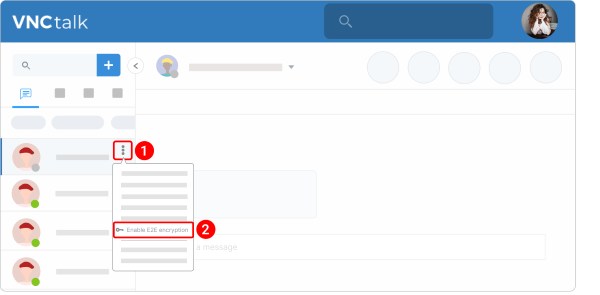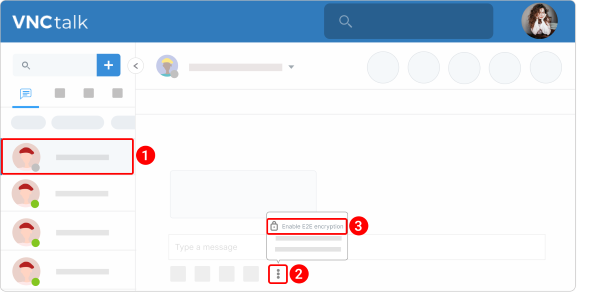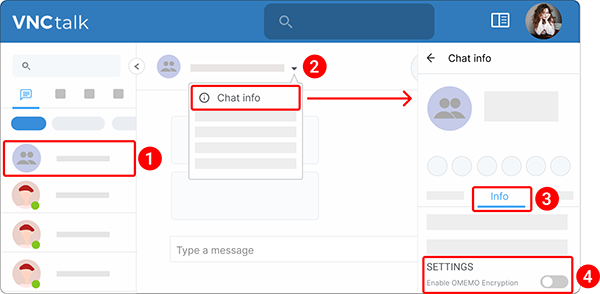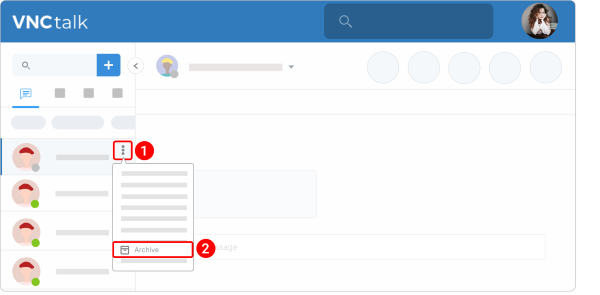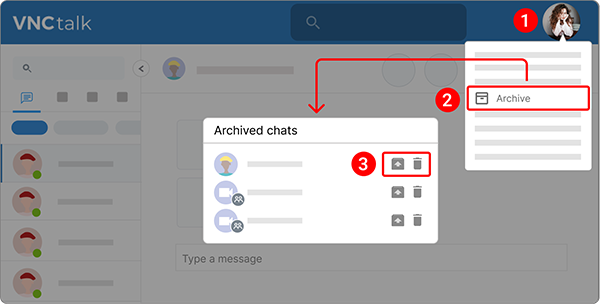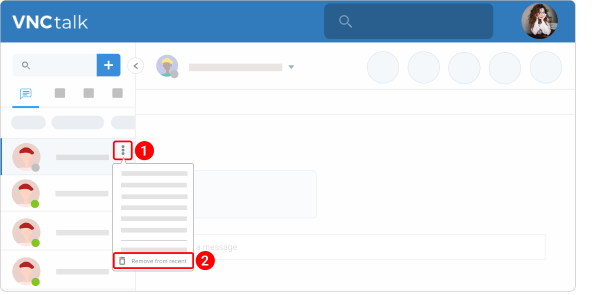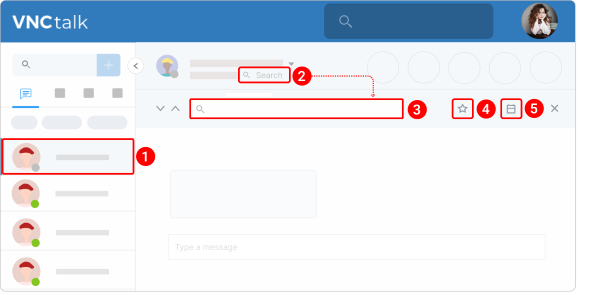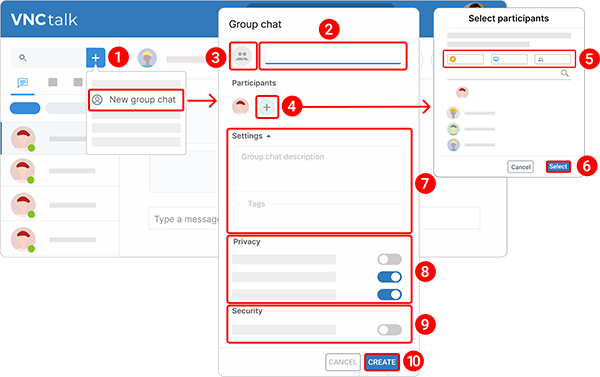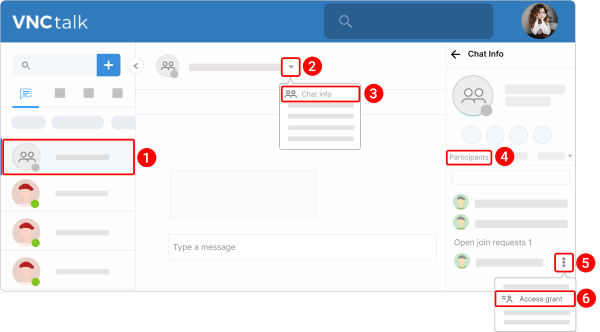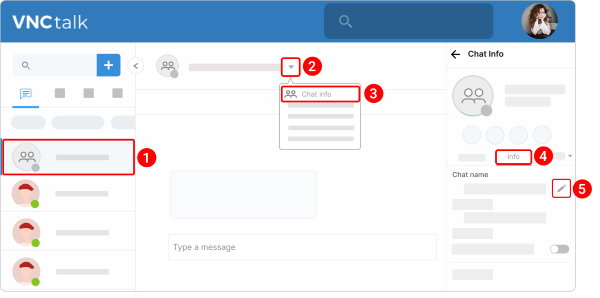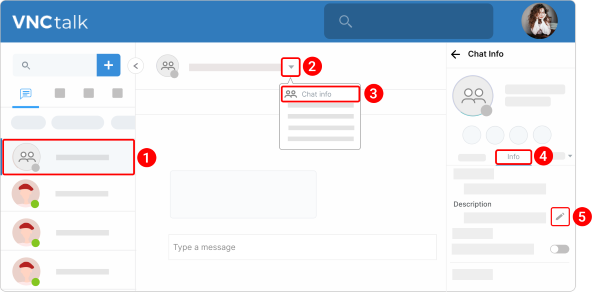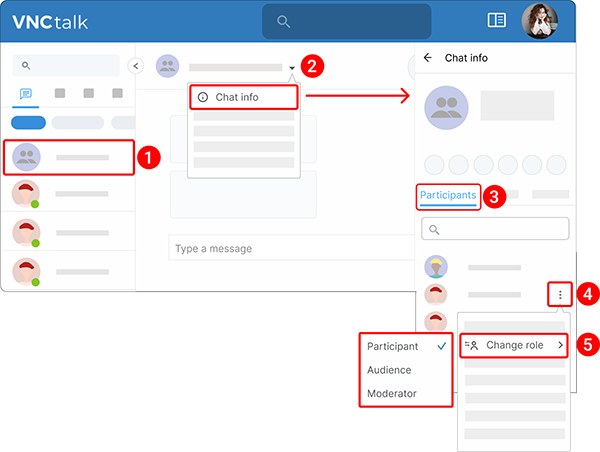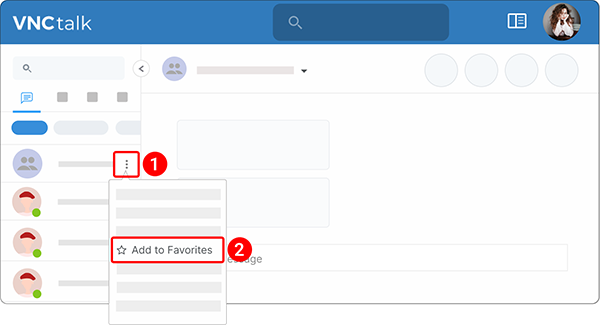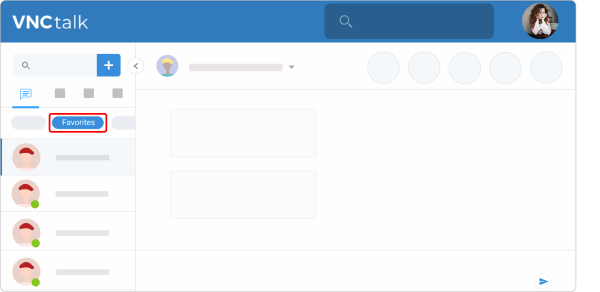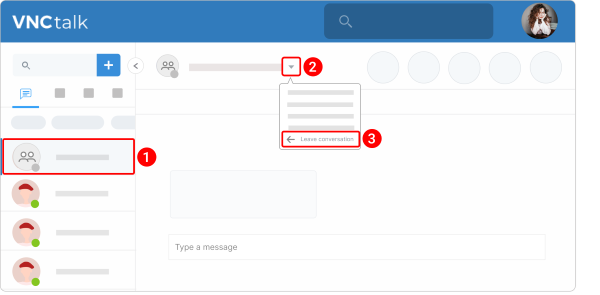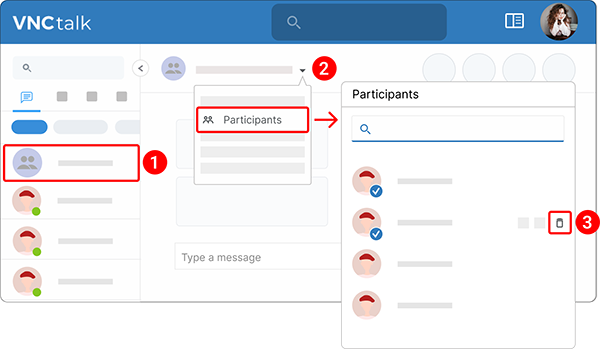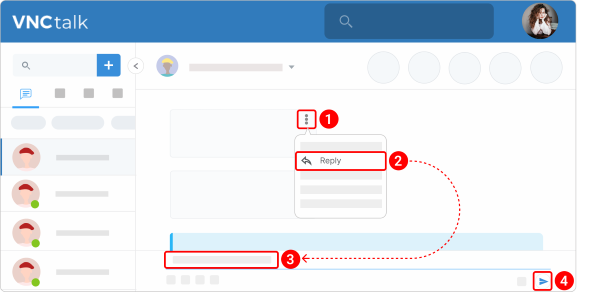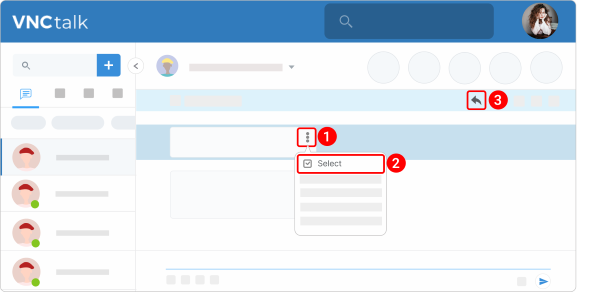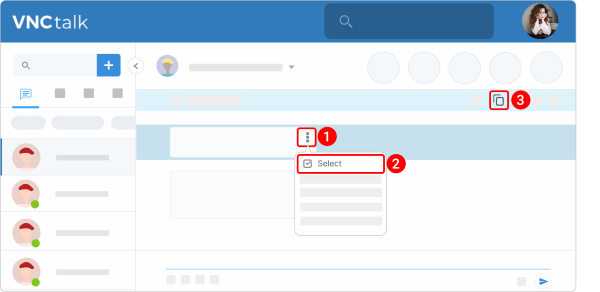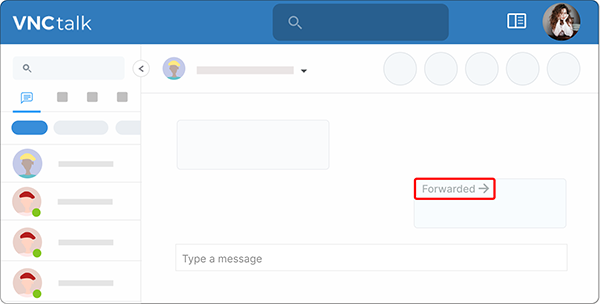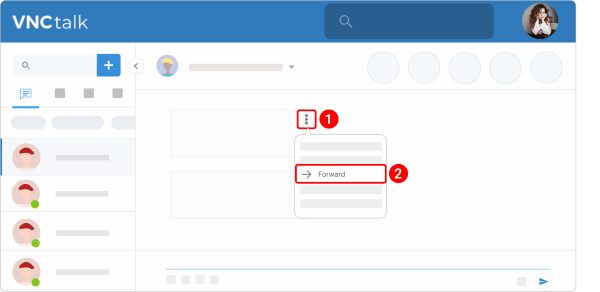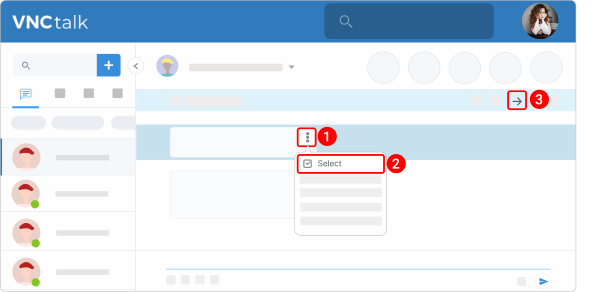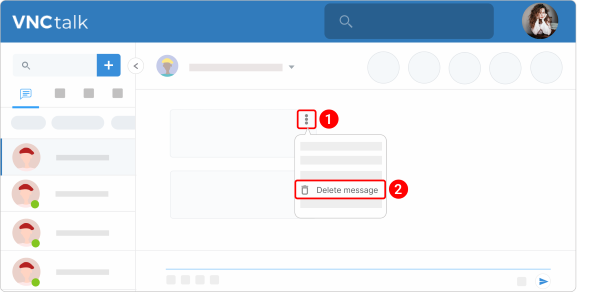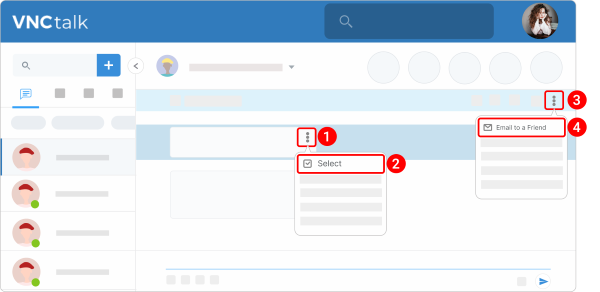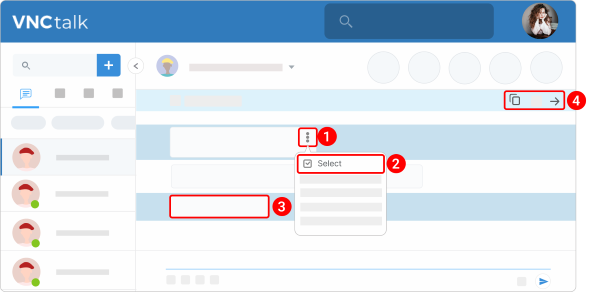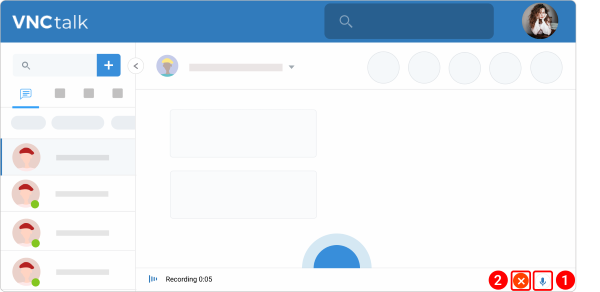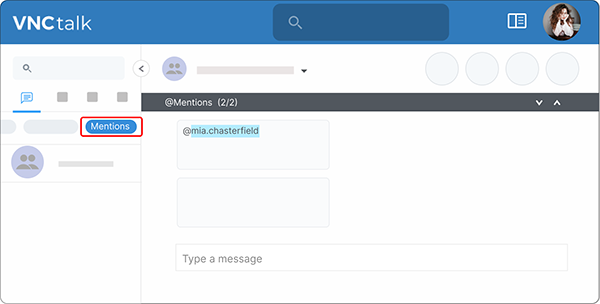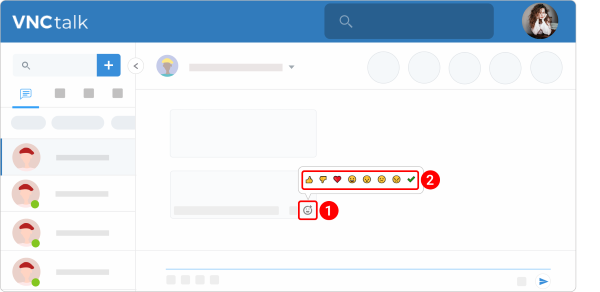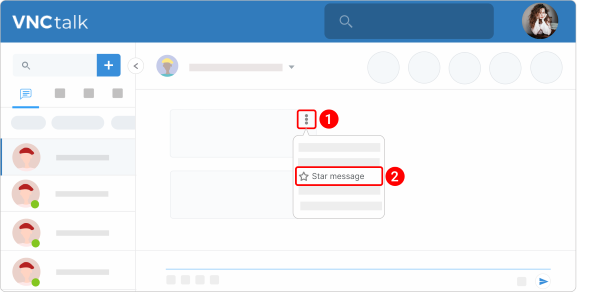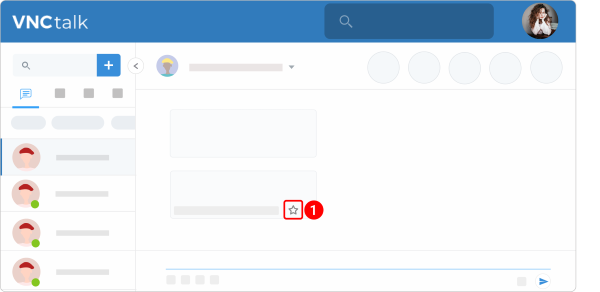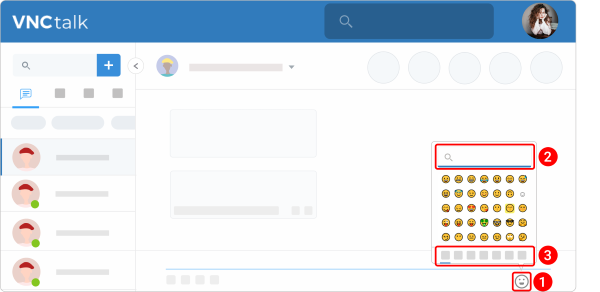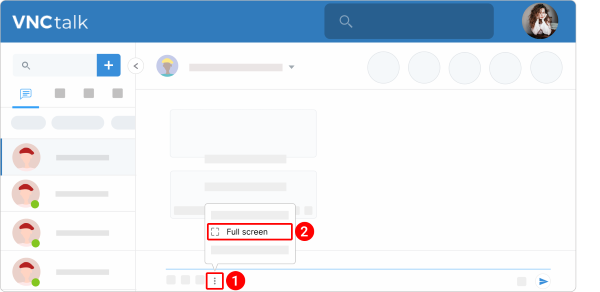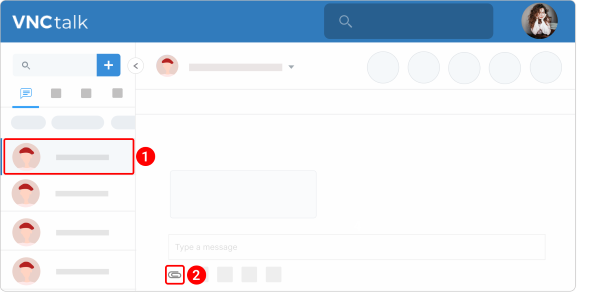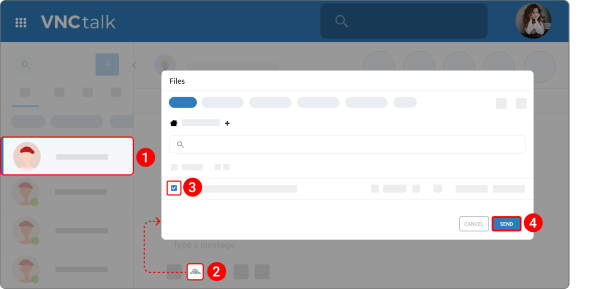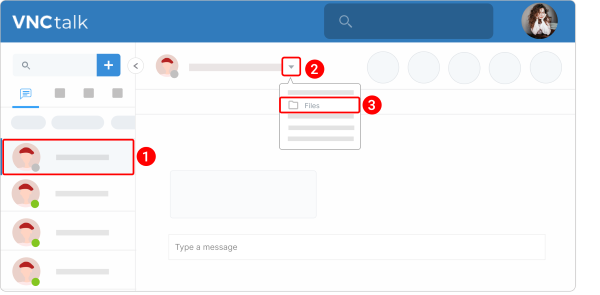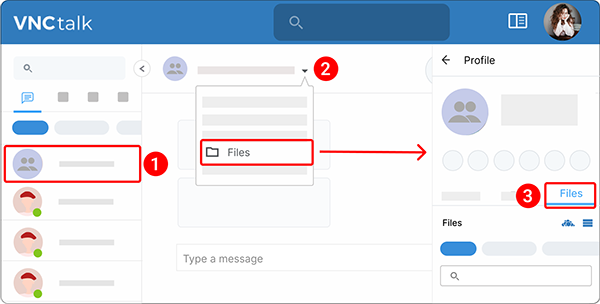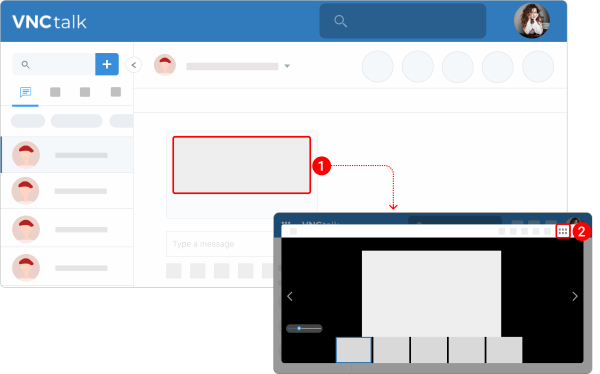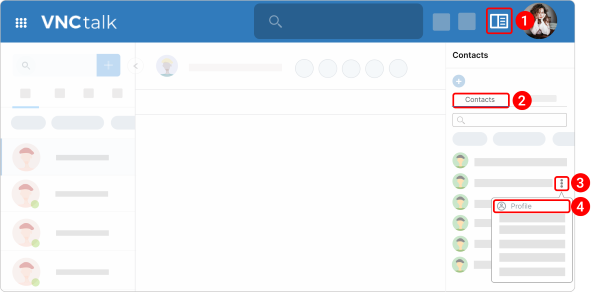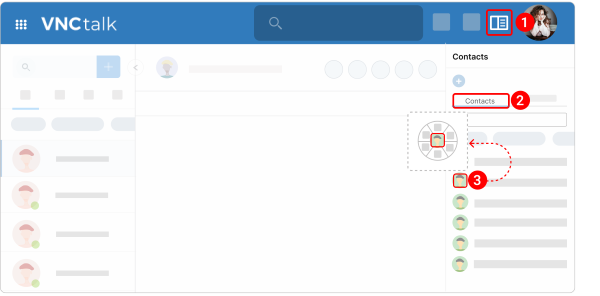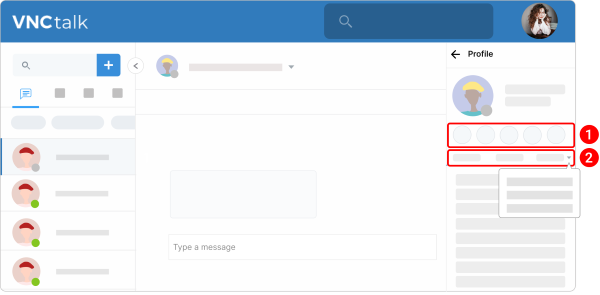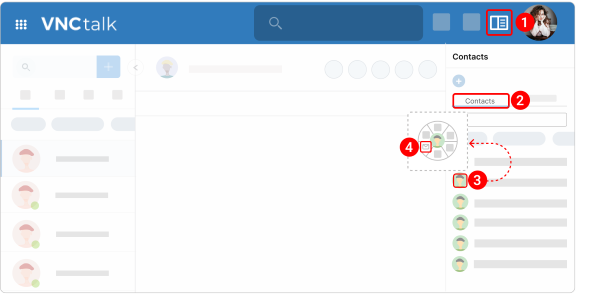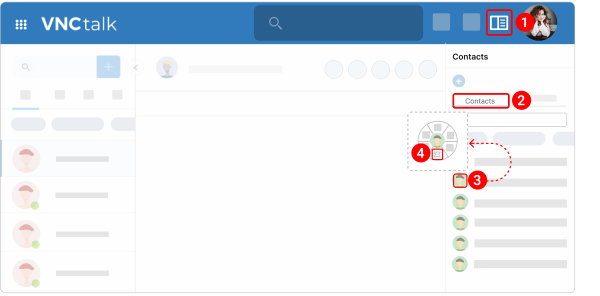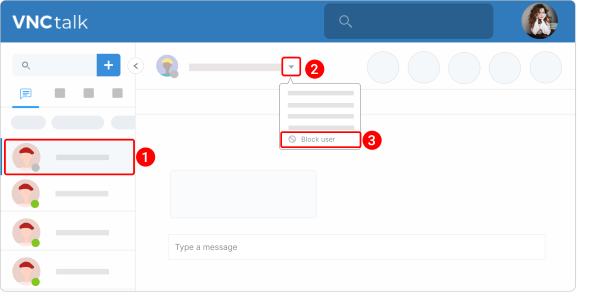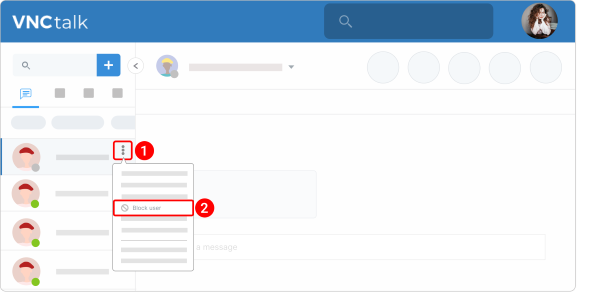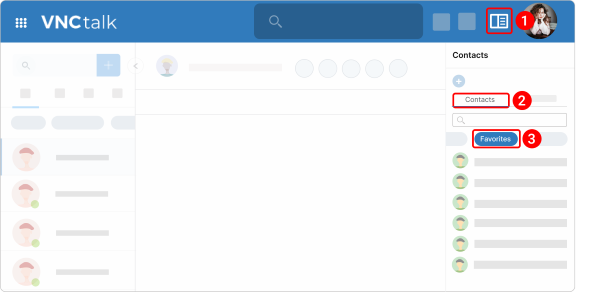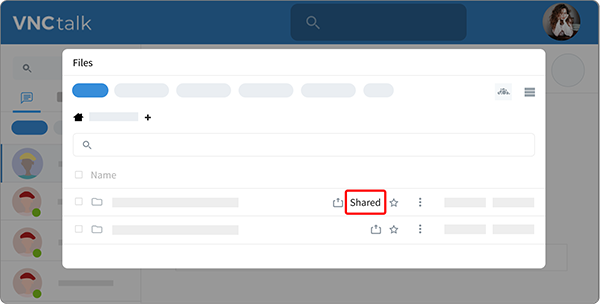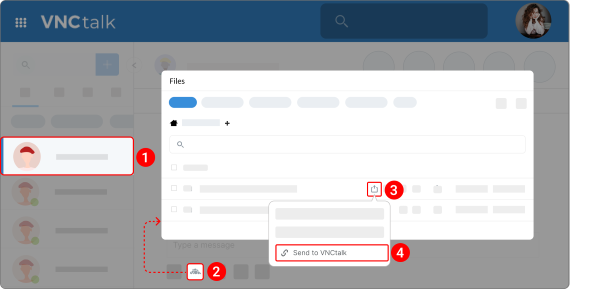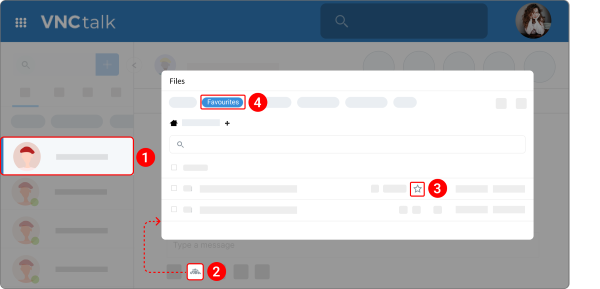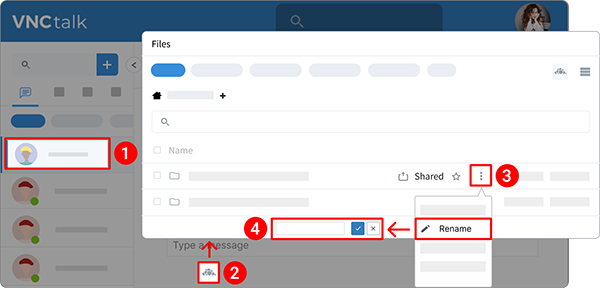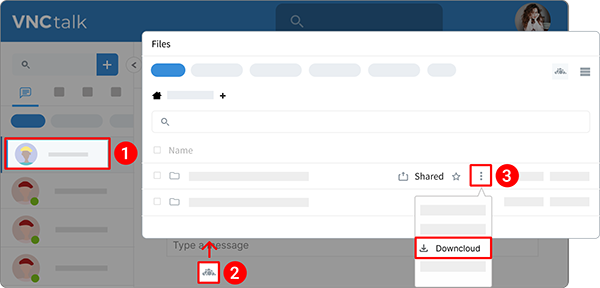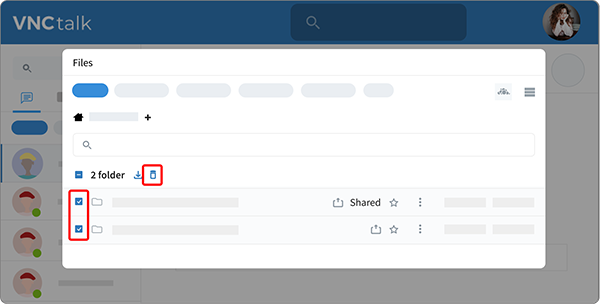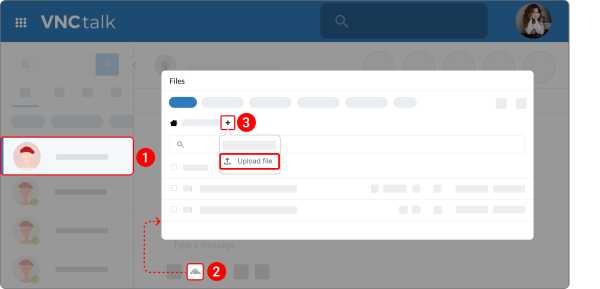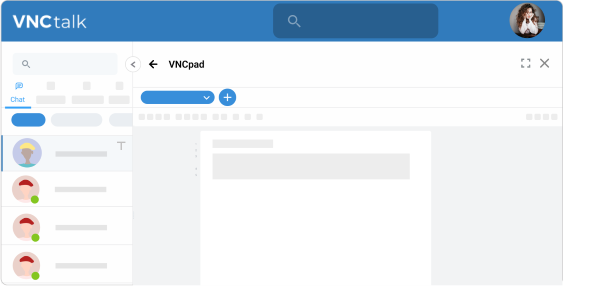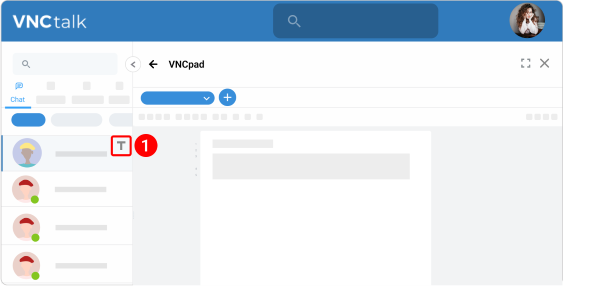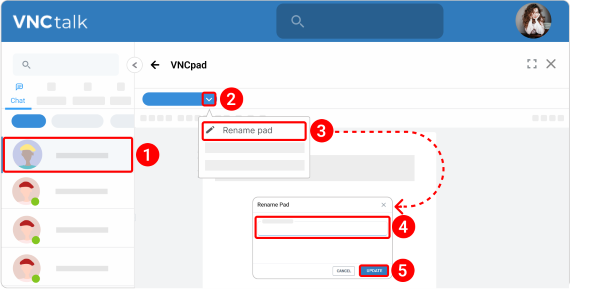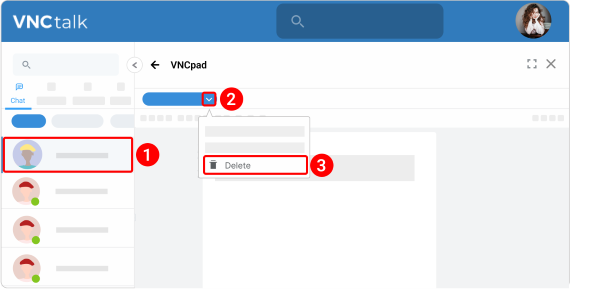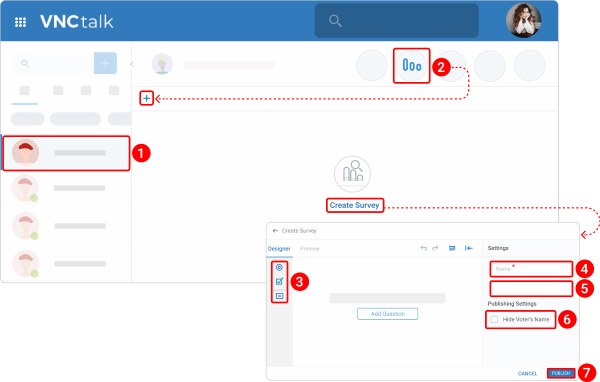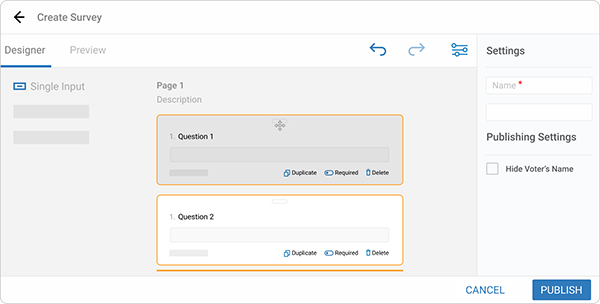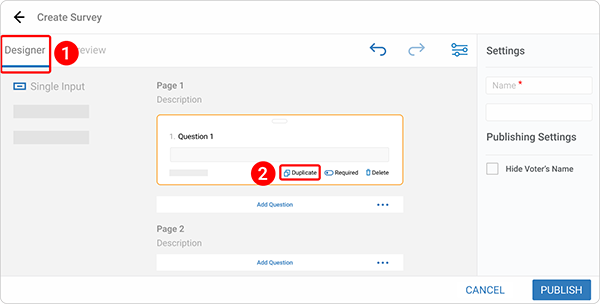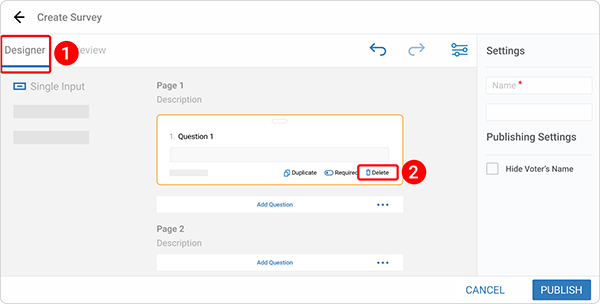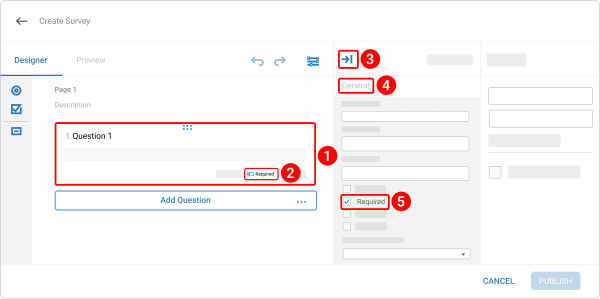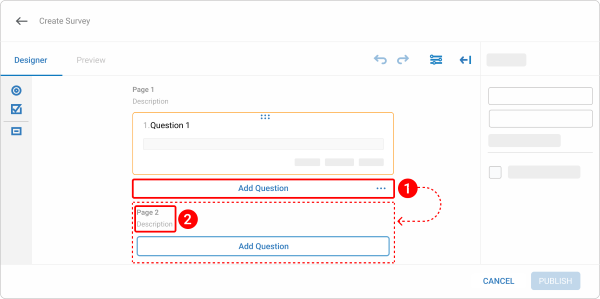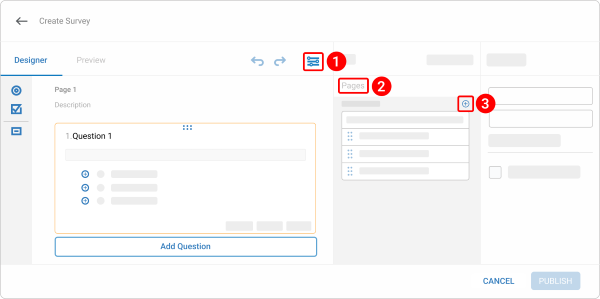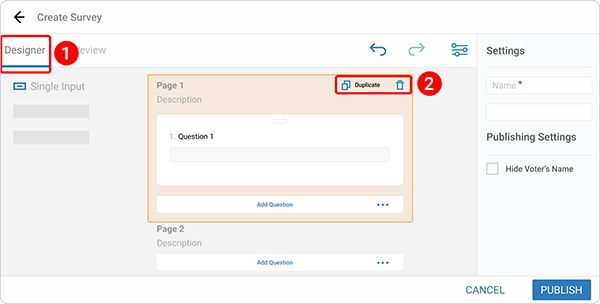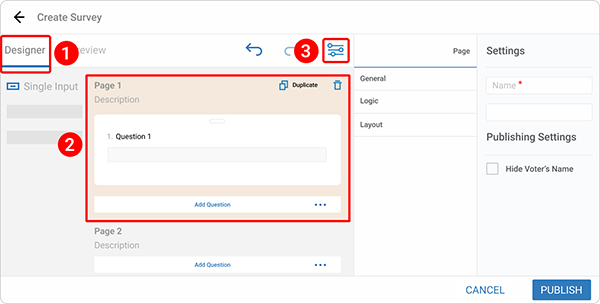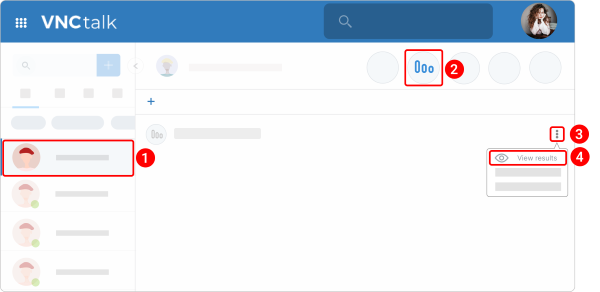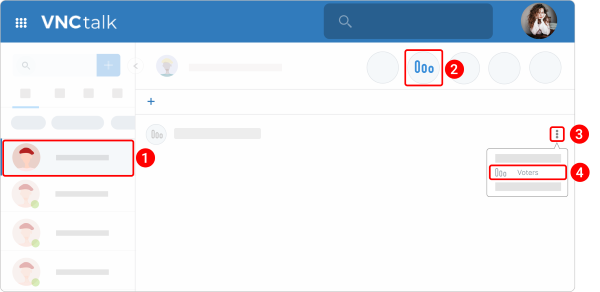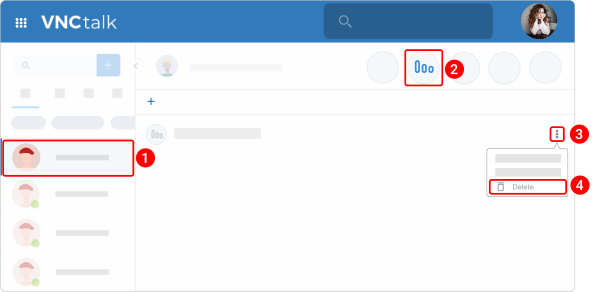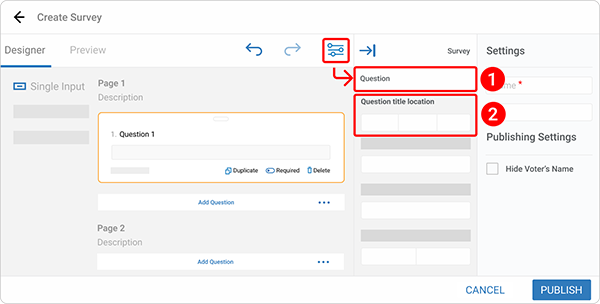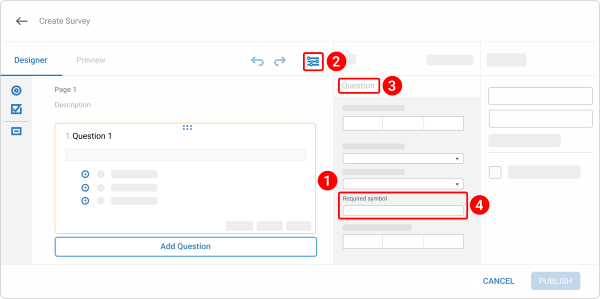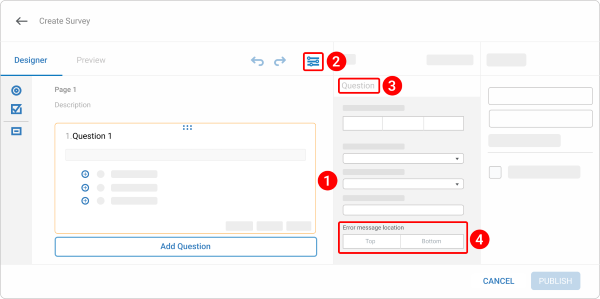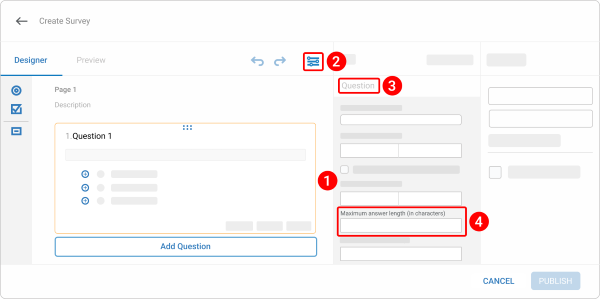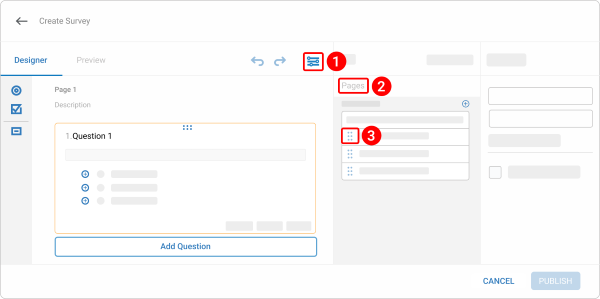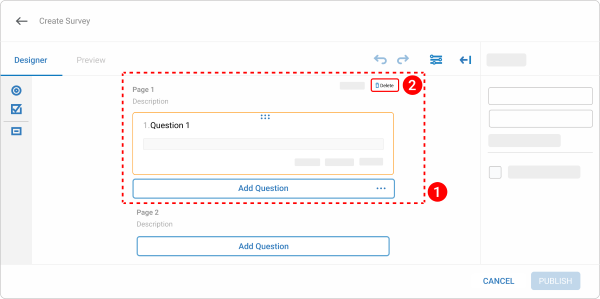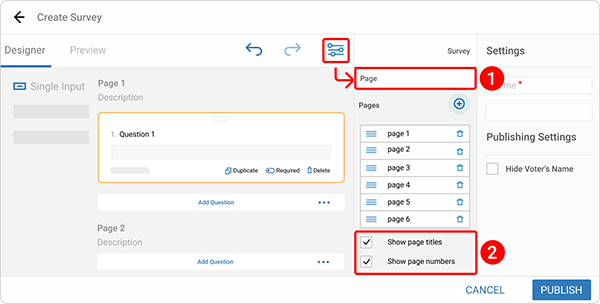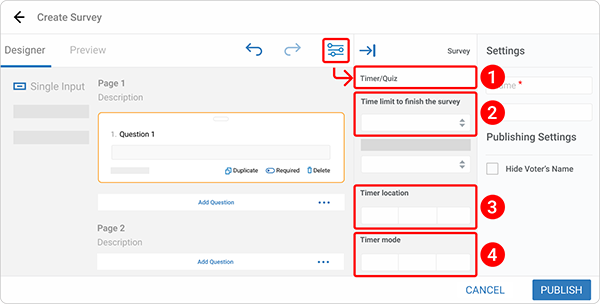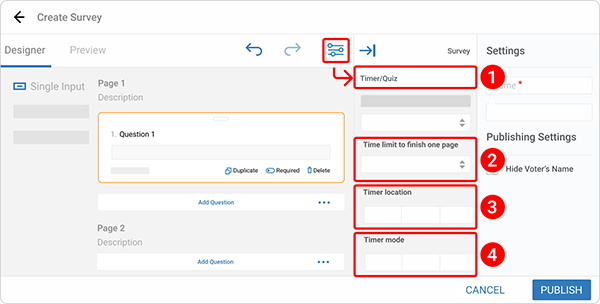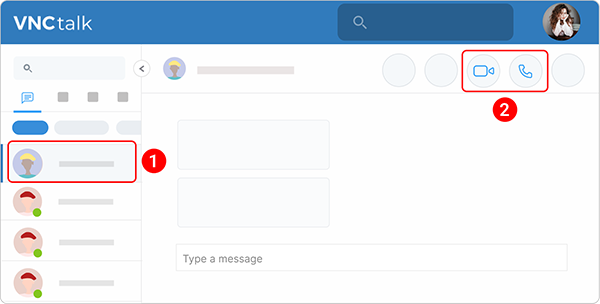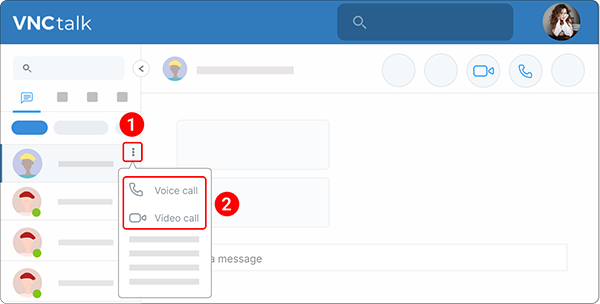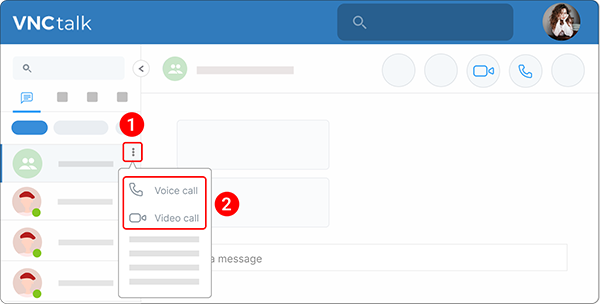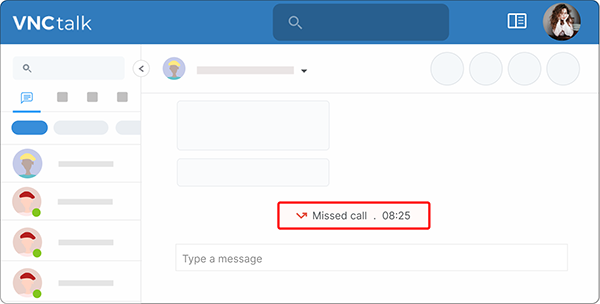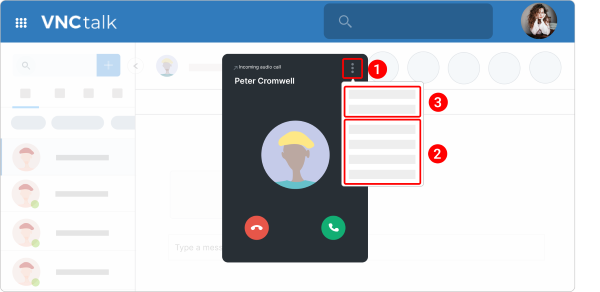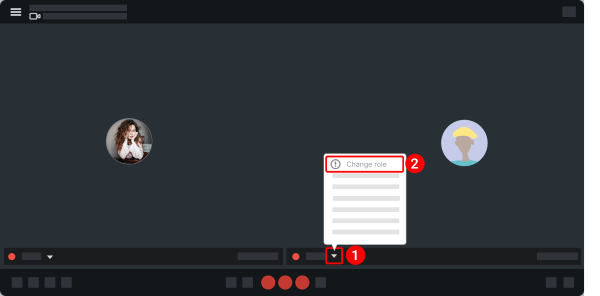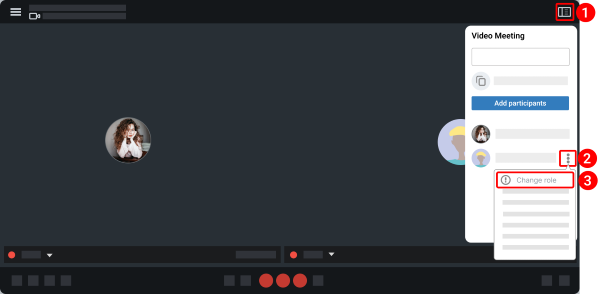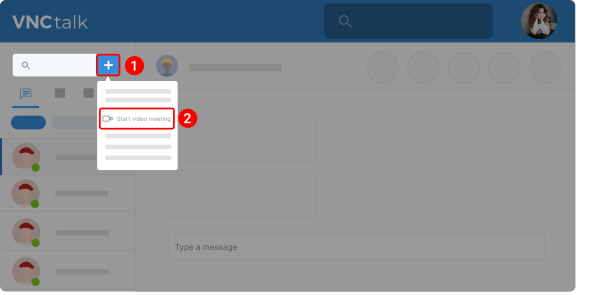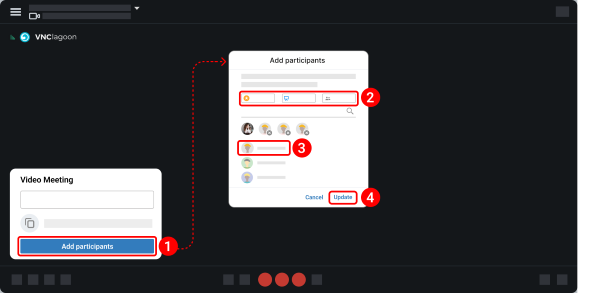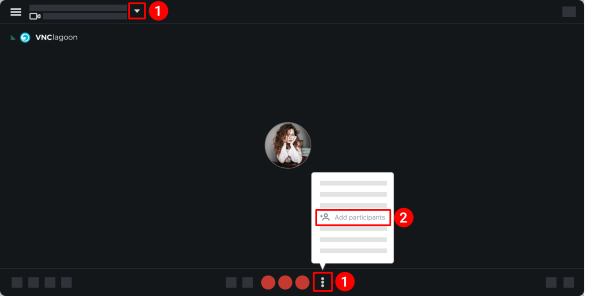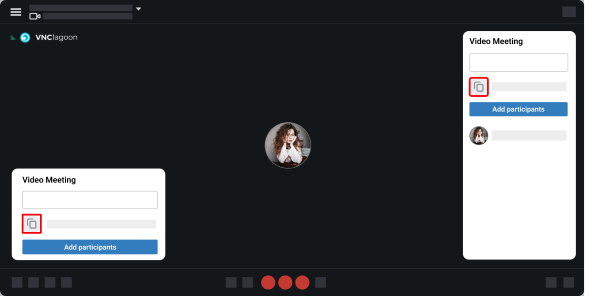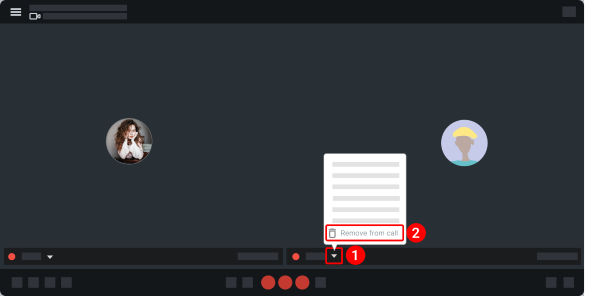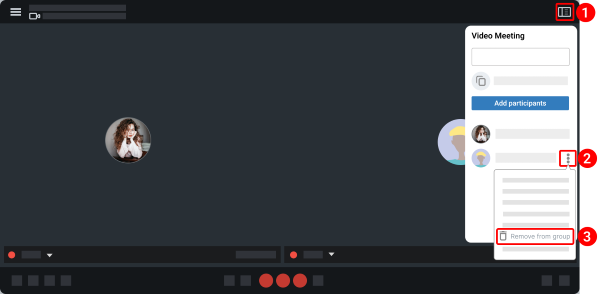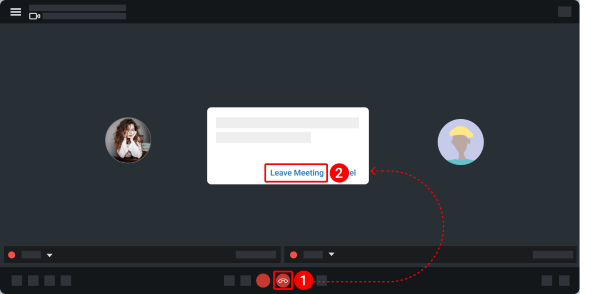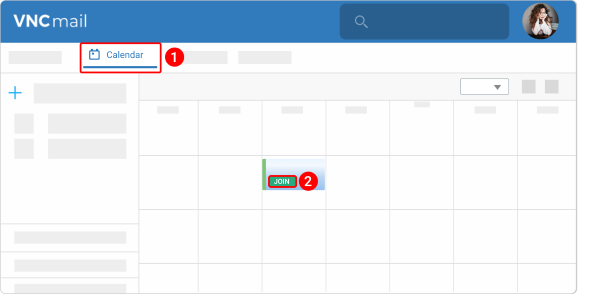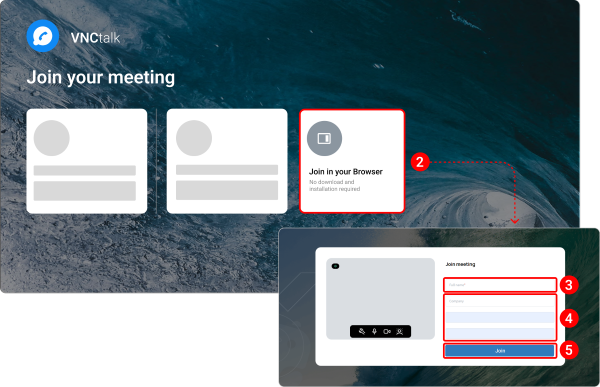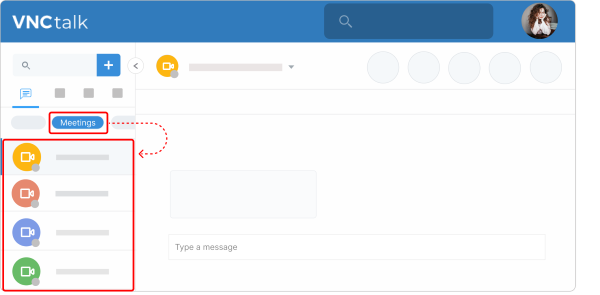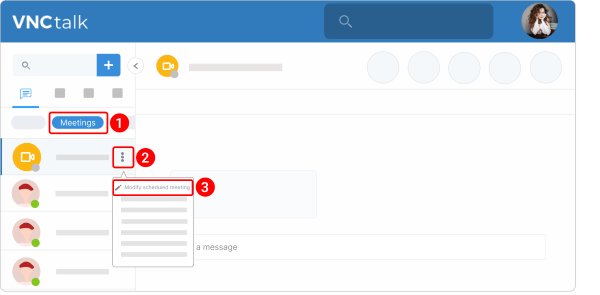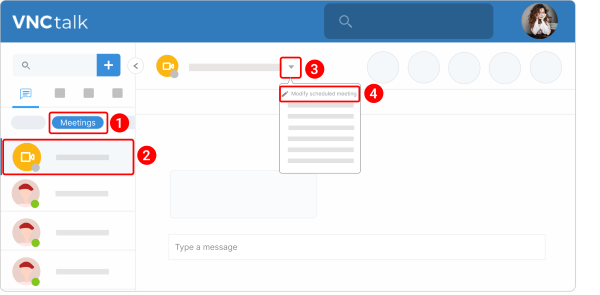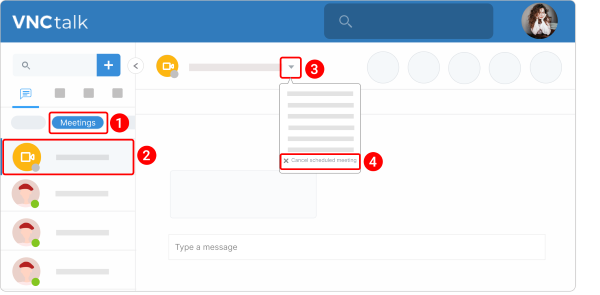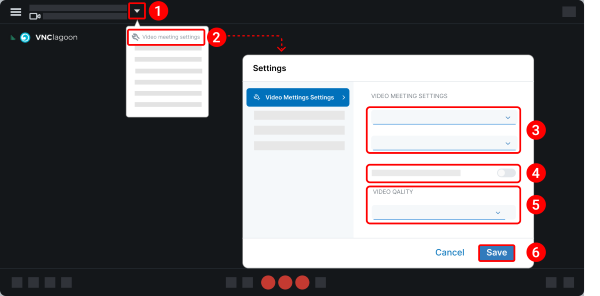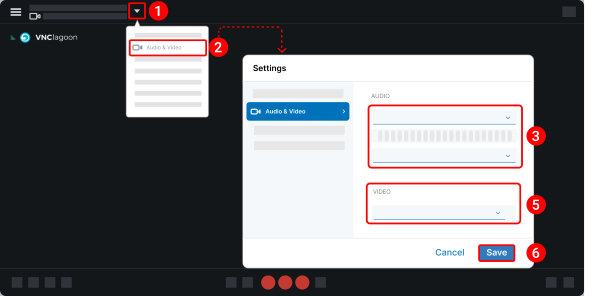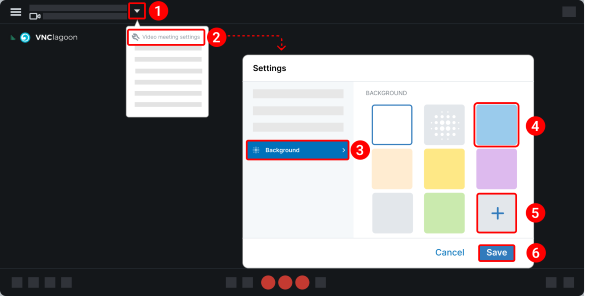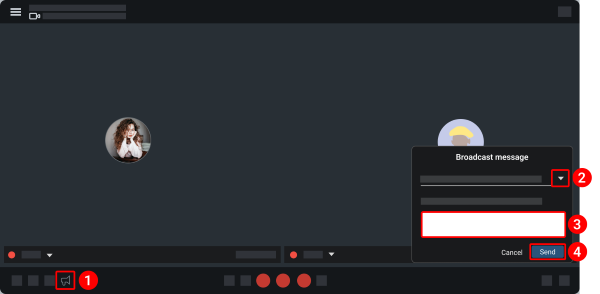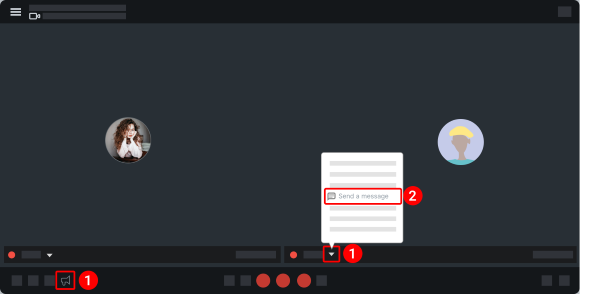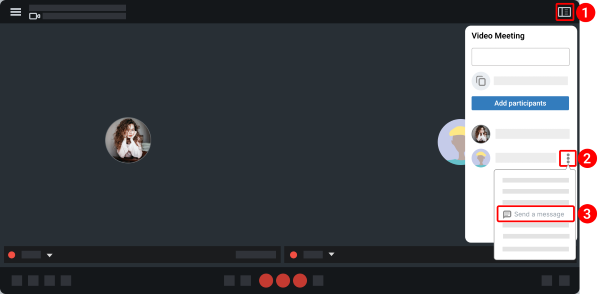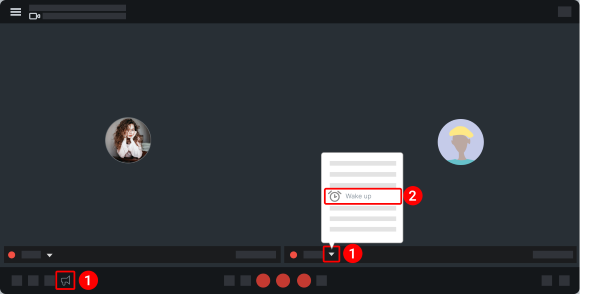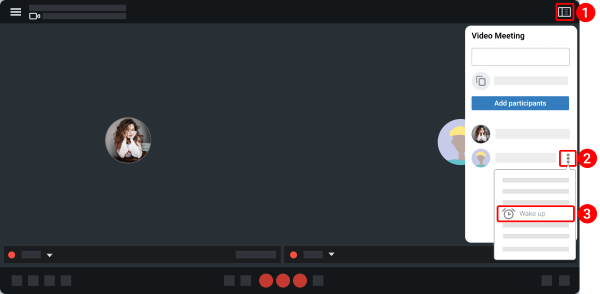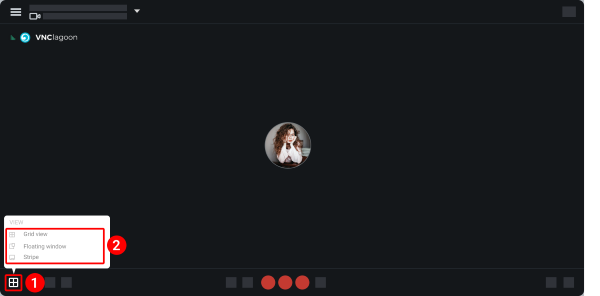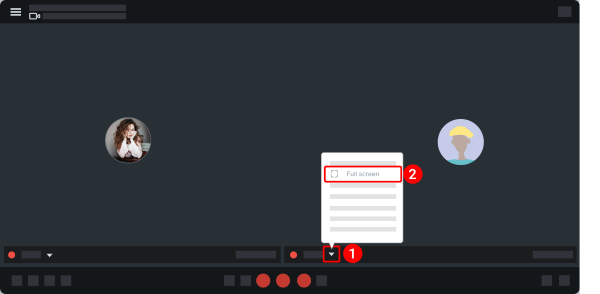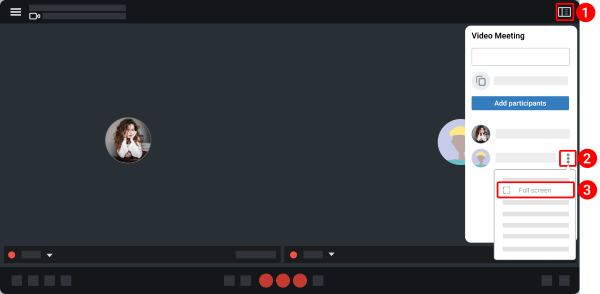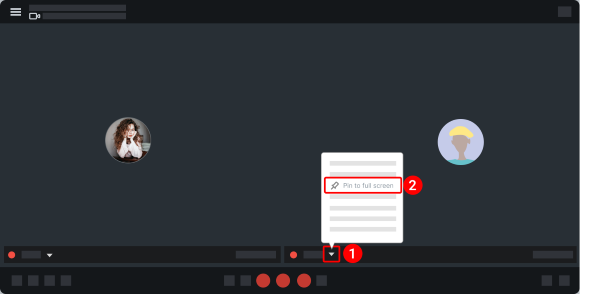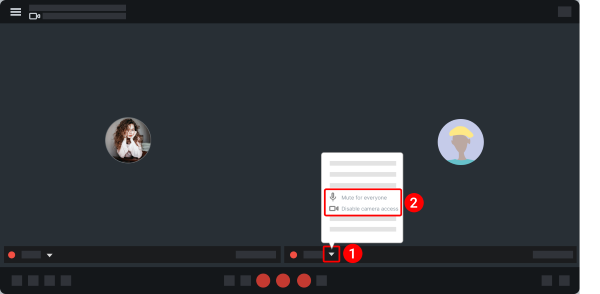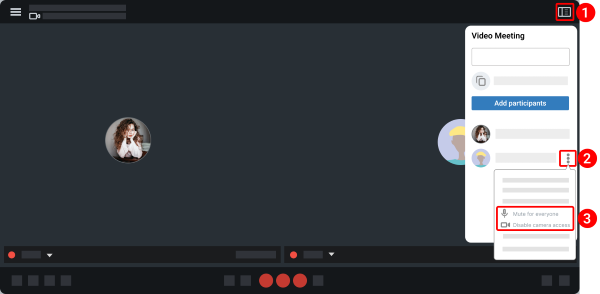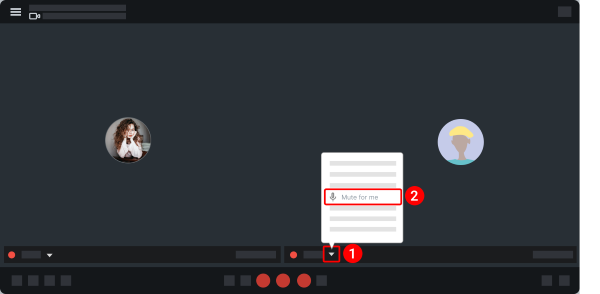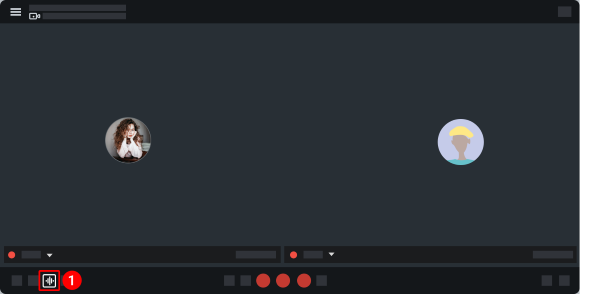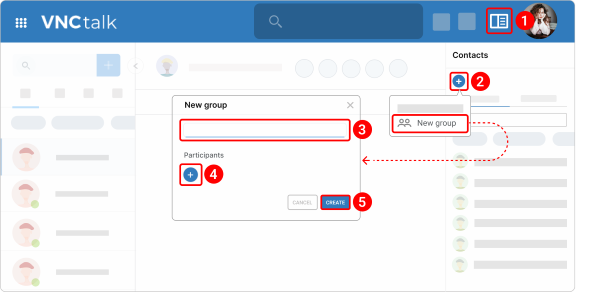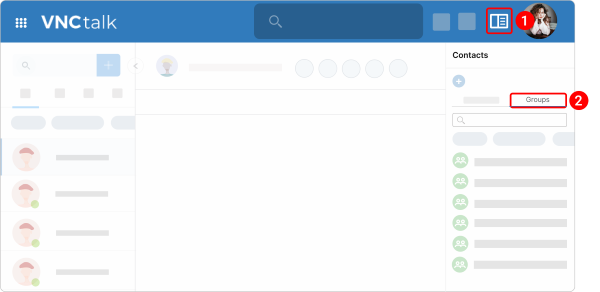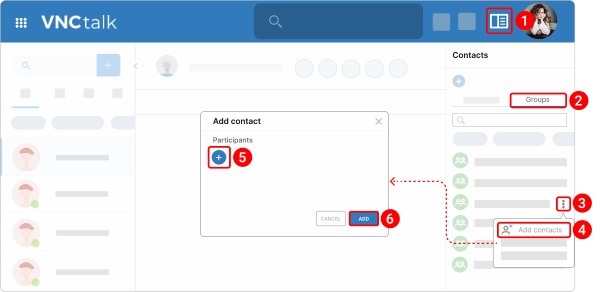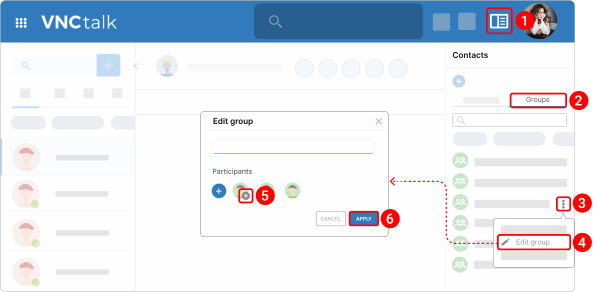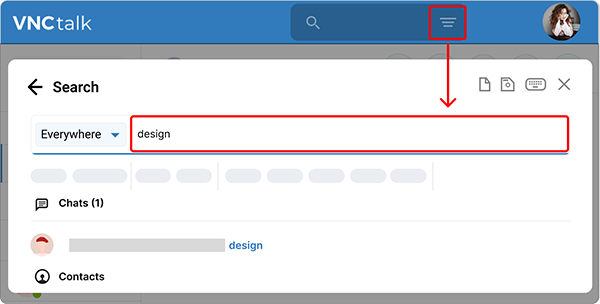VNCtalk Web/Desktop Client User Manual¶
Updated till 4.0 version
Getting started¶
Install VNCtalk Desktop Client¶
The download and installation of desktop clients are the same for all VNCproducts. Refer to the "VNClagoon Desktop Client Installation" section, for a step-by-step guide.
Create an account¶
If you create a new account in VNCtalk Desktop Client, ensure that you are using the proper URL. For this, click "Change server URL" on the login page, enter the appropriate URL, and click "Change".
-
Click Create New Account.
-
Fill in all necessary information. First name, last name, email address, and password are required.
- Click CREATE ACCOUNT. You should receive a notification email containing a link to activate your account.
- Check your email address and confirm your registration.
- Enter your credentials in the labeled fields and click LOGIN.
- Review "Terms of Use" and click Accept at the bottom.
- Choose VNCtalk from the VNClagoon start screen.
Change the profile photo¶
You can add a VNCtalk profile photo or change your current profile photo.
- In the upper right corner, click the profile icon and then Profile. The Profile sidebar opens.
- Click the pencil icon
 .
. - Hover the pointer over the current image and click Upload.
- Select an image from your device, and crop it.
- Click Apply.
Edit the profile information¶
You can customize your profile by adding a name, company, and position.
- In the upper right corner, click the profile icon.
- Click Change user info.
- Edit the profile information.
- Once you've finished, click UPDATE.
Change the VNCtalk icon and image¶
You need to be Admin to change the default VNCtalk icon and image.
You can customize the VNCtalk appearance settings by changing the icon (1) and image (2).
The procedure for changing the VNCtalk icon and image is the same for all VNC applications. Refer to the "Customize organization settings" section for the step-by-step guide.
Add a logo to the VNCtalk header¶
You need to be Admin to add a logo to the VNCtalk header.
The logo appears at the top of the VNCtalk main page.
The procedure for adding the logo to the VNCtalk header is the same for all VNC applications. Refer to the "Customize an application logo in the header" section for the step-by-step guide.
Check the application version¶
- In the upper right corner, click the profile icon.
- Navigate to Help > App info.
Contact VNC Service Desk¶
You can submit a support request at any time through VNC Service Desk. Adding a support request is a good option if:
- You face any issues with your VNCtalk application.
- You want to report a bug.
- You have feature requests.
To add a support request:
- In the upper right corner, click the profile icon.
- Navigate to Help > VNC service desk.
- Click Visit VNC service desk.
In your support request, try to provide as much detail as possible about the issue or request.
Access User Manual¶
If you need more information about VNCtalk or need some instructions, you can access "VNCtalk Web Client and Desktop Client User Manual".
- In the upper right corner, click the profile icon.
- Navigate to Help > Manuals & Documents.
- Click the required document.
Access "Terms of use"¶
A Terms of service agreement provides details about the relationship between VNClagoon products and users. It sets forth clauses that embody the rules, requirements, restrictions, and limitations that a user must agree to in order to use the VNClagoon products.
- In the upper right corner, click the profile icon.
- Navigate to Legal notice > Terms of use.
Access "Data Privacy Policy"¶
Data Privacy Policy provides details about what type of information is collected and tracked on the website, how the information may be used, and with whom the information may be shared.
- In the upper right corner, click the profile icon.
- Navigate to Legal notice > Data Privacy:
Go to other VNC products¶
You can go to another VNC product from VNCtalk if you have a subscription to the product. It means that you do not need to open the product URL in a browser and enter your credentials to log in.
- In the upper left corner, click the bento menu icon
 . You should see only the products you are subscribed to.
. You should see only the products you are subscribed to. - Click a required product and you should be redirected to this product.
Log out¶
Logging out of an account in VNCtalk does not delete your account.
- In the upper right corner, click the profile icon.
- From the drop-dowm menu, select Logout.
- Confirm that you want to log out, click LOGOUT.
Global settings¶
Global settings allow you to customize language, date format, time format, timezone, and more.
To change your global settings:
- Click the profile icon.
- Navigate to Settings > Global Settings.
- Customize your settings.
- Click Save.
Customize the language¶
The Language option allows you to select the language that you want to use. It is possible to set up 3 languages: English, German, and French.
Change date format¶
Date settings present you with several formatting options.
| Date order | Description |
|---|---|
| dd.MM.yyyy | Day-Month-Year with leading zeros and points (.) as the separator characters (17.02.2022). |
| MM/dd/yyyy | Month-Day-Year with leading zeros and backslashes (/) as the separator characters (02/17/2022). |
| dd/MM/yyyy | Day-Month-Year with leading zeros and backslashes (/) as the separator characters (17/02/2022). |
Change time format¶
You can change how the clock (12-hour or 24-hour) appears on your display.
If the format contains an AM or PM, the hour is based on the 12-hour clock, where "AM" indicates times from midnight until noon and "PM" indicates times from noon until midnight. Otherwise, the hour is based on the 24-hour clock that uses the numbers 00:00 to 23:59 (midnight is 00:00).
Change timezone¶
You can change the time zone in VNCtalk so that it matches your current location.
Enable/ disable "Send message with ENTER" option¶
VNCtalk automatically sends a message when you hit the Enter key while composing. However, you can change the behavior by default and make it start a new line, and keep composing the same message.
To change the action assigned to the "Enter" key by default, switch off the Send message with ENTER toggle.
Enable/ disable "Add date stamp along with time stamp" option¶
If you enable the "Add date stamp along with time stamp" option, you will be able to add a date to a time stamp on messages.
Enable/ disable the "Allow screen share preview for the presenter" option¶
By default, the option is disabled. If you enable the option, you can select what to share:
- Your entire screen lets you show everything on your screen.
- Application window lets you share an open window like a specific app you have open.
- Chrome tab lets you share a single Chrome browser tab, hiding other tabs and windows. This option requires the Chrome browser.
Notification and sound settings¶
VNCtalk offers different ways to receive and manage notifications. These settings include how, when, and where your notifications appear, custom settings for chats, channels, broadcasts, sounds, and so on.
Enable/ disable chats, channels, and broadcasts notifications¶
You can control which types of notifications you want to enable.
To enable chats, channels, and broadcasts notifications:
- In the upper right corner, click the profile icon.
- Navigate to Settings > Notifications & Sound.
- Click Change.
- Select which types of notifications you would like to receive.
- Click Save.
Customize chat notifications¶
- To be notified about upcoming conference video calls, toggle on Conference video call reminders.
- To be notified about missed calls, toggle on Notify about missed calls.
- To be notified only when you are @mentioned, toggle on Mentions.
Customize channel notifications¶
- To be notified when there is a new topic on a channel you subscribed on, toggle on New topic in a channel you subscribed on.
- To be notified when someone invites you to a channel, toggle on Invite to a channel.
- To be notified about new comments and replies to your comments, toggle on New comment in a topic you subscribed on and Replies to your comments respectively.
All notifications for that type of activity will be sent to the activity button  , which you can find in the upper right corner.
, which you can find in the upper right corner.
Customize broadcast notifications¶
- To turn on broadcast notification sounds, toggle on Enable notifications.
-
To turn on the broadcast notification badge, toggle on Show badge.
- An icon badge displays as a small circle and a number on the corner of a product's icon. If an app has one or more notifications, it will have a badge. If the badges are not displaying, you'll need to enable the notifications for that product and then turn on the product icon badges.
Customize notification badge color¶
- In the upper right corner, click the profile icon.
- Navigate to Settings > Notifications & Sound.
- Select a required color from the Badge color drop-down menu.
- Click Save.
Customize sticky notifications¶
The "Sticky notifications" option does not work in Firefox browser.
- In the upper right corner, click the profile icon.
- Navigate to Settings > Notifications & Sound.
-
Select a required option from the Notifications drop-down menu:
- No notifications - if you select this variant, you will not see a message notification in a browser when someone sends you a message;
- Show non sticky notifications - if you select this variant, you will see a message notification in a browser when someone sends you a message, but the notification will disappear in some time;
- Show sticky notifications - if you select this variant, you will see a message notification in a browser when someone sends you a message and the notification will be visible until you click it or close it.
-
Click Save.
Customize email notifications¶
You can receive email notifications to alert you about new message(s). The email notifications suggest 2 setting variants:
- Email Notification period — allows selecting the time period for the notifications;
- Email Notifications repeats — allows selecting the notifications repeats.
To customize email notifications:
- In the upper right corner, click the profile icon.
- Navigate to Settings > Notifications & Sound.
- Select a required option from the Email Notification Period and Email Notifications repeats drop-down menus.
- Click Save.
Customize sound settings¶
- In the upper right corner, click the profile icon.
- Navigate to Settings > Notification & Sound.
- From the drop-down menu, select a required ringtone. The menu is visible only in case the Enable sounds toggle is switched on.
- Click the play button
 to listen to the selected ringtone.
to listen to the selected ringtone. - Click Save.
Enable/ disable the global mute¶
If you enable the global mute, you will mute all notifications within the application.
- In the top menu, click the microphone icon
 and it will turn red, confirming that you mute all notifications.
and it will turn red, confirming that you mute all notifications. - To disable the global mute: click the microphone icon
 again.
again.
Audio and video settings¶
You can adjust your camera and microphone, customize the background, check the sound, and more.
Customize video meeting settings¶
Video meeting settings allow you to:
- customize the top and bottom bars in a video meeting. By default, they are always visible during a video meeting. But you can customize them and they will be visible only if you hover the pointer over them;
- adjust video quality;
- enable the pop-up window to confirm that you want to leave a video meeting.
Before you start a video meeting:
- In the upper right corner, click the profile icon.
- From the drop-down menu that opens, select Audio/ video settings. The "Settings" dialog box will open.
- On the left-side vertical navigation, select Video meeting settings.
-
Under the VIDEO MEETING SETTINGS section, select a required option from Behavior of the top bar and Behavior of the bottom bar:
- Always show — if you want the top/ bottom bar to be always visible;
- Show on mouse over, hide on mouse out — if you want the top/ bottom bar to appear when you hover the pointer over it and to disappear when you remove the pointer.
-
If you want to have the pop-up window to confirm that you want to leave a video meeting, toggle on the Show confirmation box when leaving video conference.
-
Under the VIDEO QUALITY section, select an appropriate option from the Select the video quality drop-down menu:
- High Definition and Standard Definition options are appropriate when you do not have issues with the internet connection;
- Low Definition or Low Bandwidth options are appropriate when you have some issues with the internet connection.
-
Click Save.
Customize audio/ video settings¶
- In the upper right corner, click the profile icon.
- From the drop-down menu that opens, select Audio/ video settings. The "Settings" dialog box will open.
- On the left-side vertical navigation, select Audio & Video.
-
Under the AUDIO section, customize the following settings:
- Input — the drop-down menu may suggest the types of input devices in case you have some external headphones connected. For example, if you use a laptop and you do not have some external headphones connected, the laptop microphone will be used for the input sound. In this case, only the default option is available in the drop-down menu. But if you connect the external headphones, you will be able to select them from the drop-down menu.
- Level. To check that your sound and microphone work properly, just say something.
- Output — the drop-down menu may suggest the types of output devices in case you have some external headphones connected. For example, if you use a laptop and you do not have some external headphones connected, the laptop microphone will be used for the output sound. In this case, only the default option is available in the drop-down menu. But if you want to use your headphones, you can connect them and select them from the drop-down menu.
-
Under the VIDEO section, customize the video settings. The drop-down menu may suggest the types of cameras in case you have some external camera connected. For example, if you use a laptop without an external camera connected, the laptop camera will be used when you have a video call/meeting. But if you connect some external camera, you will be able to select it from the drop-down menu.
- Click Save.
Customize the background in a video meeting¶
- In the upper right corner, click the profile icon.
- From the drop-down menu that opens, select Audio/ video settings. The "Settings" dialog box will open.
- On the left-side vertical navigation, select Background.
- Click on an image to select the desired virtual background.
- Click Save.
Security and privacy settings¶
You can control your privacy by enabling/ disabling two-factor authentication and making certain information private or public.
Enable/ disable 2 Factor Authentication¶
Two-factor authentication (2FA) allows you to add an extra level of security to your account. Besides using your login and password, enabling 2FA requires you to enter a one-time password code every time you log into your account. The code is automatically generated by an application on your phone.
- Download an authenticator application on your phone. We recommend Google Authenticator for Android and iOS users.
- In the upper right corner, click the profile icon.
- Navigate to Settings > Security & Privacy.
- Toggle on Enable 2 Factor Aunthentication.
- Click Start Authenticator app.
- Scan the QR code with your authenticator application on your phone.
- Enter the six-digit code from the application.
- Click Save changes.
Remove OMEMO device¶
You can have up to 5 OMEMO encrypted devices.
When you hit the maximum number of OMEMO encrypted devices, you can't log in to VNCtalk with a new device. In that case, you'll get the notification stating "Exceeded OMEMO limit. Please deselect one of the devices first to enable encryption from the current device":
To disable one of the previous devices:
- In the upper right corner, click the profile icon.
-
Navigate to Settings > Security & Privacy.
- You can also click OPEN SETTINGS in the "OMEMO devices limit exceeded" modal box.
-
Under the OMEMO DEVICES section, click the trash bin icon
 next to the device you want to disable.
next to the device you want to disable. - When prompted, click Ok to confirm that you want to delete the device.
Then refresh the page so the current device will be added automatically.
Transfer secure chats¶
After you log in to VNCtalk, your device is registered in the system and assigned an ID. The ID looks as follows: 10161 Mobile Android 2021-02-24. Where:
- 10161 — is a device ID;
- Mobile — is a hardware type;
- Android — is an operating system of a hardware type;
- 2021-02-24 — is a log in date from a device.
To check the devices ID in your VNCtalk account, click the profile icon and then navigate to Settings > Security & Privacy:
Imagine that you enable E2E encryption for a group chat in the VNCtalk Web Client. Let's call the group chat "Testing" in this imaginary situation. Then you install VNCtalk Desktop Client and log in to the application for the first time. When you open the "Testing" group chat, you should see that you cannot read the previous messages because they are encrypted:
Can't decrypt the message - not intended for the current device
To read the previous messages, you should transfer them from VNCtalk Web Client to Desktop Client. To do that, follow the steps below:
-
Log in to VNCtalk:
- on a device that you want to transfer encrypted messages from
- on a device that you want to transfer encrypted messages to
-
In the VNCtalk app on the device that you want to transfer messages from, click the profile icon in the upper right corner.
- Navigate to Settings > Security & Privacy.
- Click SELECT CHATS.
-
Select a chat that you want to transfer encrypted messages from and click START at the bottom. You should see the notification stating "Started discovering nearby devices".
-
Get back to VNCtalk on a device that you want to transfer encrypted messages. Click Accept in the Transfer secure chats modal box. You should see the notification stating "The chats are transferred successfully".
After the transfer is over, you can read encrypted messages.
Enable/ disable the "Read receipts" option¶
Check marks will appear next to each message you send. Here's what each one indicates:
 The message was successfully sent.
The message was successfully sent.
 The recipient has read your message.
The recipient has read your message.
The "Read Receipts" option allows you to see whether the recipient has read your message or seen your image/ video or not.
- In the upper right corner, click the profile icon.
- Navigate to Settings > Security & Privacy.
- Under the PRIVACY section, toggle on or off Enable receipts.
- Click Save.
Enable/ disable the "Inform about typing" option¶
If you enable the "Inform about typing" option, other users will be able to see if you are typing a message at the moment.
- In the upper right corner, click the profile icon.
- Navigate to Settings > Security & Privacy.
- Under the PRIVACY section, toggle on or off Inform about typing.
- Click Save.
Enable/ disable "Publish last activity" option¶
If you enable the "Publish last activity" option, other users will be able to see when you were online last time.
- In the upper right corner, click the profile icon.
- Navigate to Settings > Security & Privacy.
- Under the PRIVACY section, toggle on or off Publish last activity.
- Click Save.
Enable/ disable "Do not load insecure content" option¶
- In the upper right corner, click the profile icon.
- Navigate to Settings > Security & Privacy.
- Under the PRIVACY section, toggle on or off Do not load insecure content.
- Click Save.
Features settings¶
The "Enable keyboard on mobile" option does not work for Web/ Desktop Client. "Enable Whiteboard" and "Enable MCB" options are available only for users with the admin rights.
VNCtalk has a lot of useful features that you may use daily in many tasks. However, some features and chat addons can be enabled and disabled.
Enable/ disable Rich Text Format¶
If you enable Rich Text Format, you will have the toolbar with icons for editing and formatting a text.
- In the upper right corner, click the profile icon.
- Navigate to Settings > Features.
- Toggle on Enable RTF editor.
- Click Save.
Enable/ disable keyboard on mobile¶
You can turn off or disable a keyboard on your Android phone.
- In the upper right corner, click the profile icon.
- Navigate to Settings > Features.
- Toggle on Enable keyborad on mobile.
- Click Save.
Enable/disable VNCtalk features¶
You can enable or disable such VNCtalk features as:
- Channels
- Social
- Broadcasts
- Whiteboard
- Pad
Once you've disabled Channels, Socials, and Broadcasts features, they disappeared from the features menu:
Once you've disabled the Pad feature, it disappeared from the header menu of the chat:
- In the upper right corner, click the profile icon.
- Navigate to Settings > Features.
- Under the SELECT FEATURES section, toggle on the features you want to enable.
- Click Save.
Appearance settings¶
You can change VNCtalk appearance settings such as theme and font size.
Customize the theme¶
There are 3 themes in the application: "VNCtalk", "Purple", and "Orange".
- In the upper right corner, click the profile icon.
- Navigate to Settings > Appearance.
- Select a required theme.
- Click Save.
Customize the font size¶
You can make your font size smaller or larger.
- In the upper right corner, click the profile icon.
- Navigate to Settings > Appearance.
- Drag the slider left and right to choose one of the font size options.
- Click Save.
Chats¶
With the chat feature in VNCtalk, you can hold instant messaging conversations with people, share content and emojis, mention people, and send documents, images, or other content.
You can also hop into a call or meeting with a person by clicking the phone or camera icons.
Start a chat¶
There are 5 ways to start a chat.
Way 1. Using the "New Chat" button.
- Click the plus icon and select New chat.
- Search or scroll through the list of existing users and click a required user.
Way 2. From the list of contacts.
- Click the notebook icon
 next to your profile image.
next to your profile image. - Go to the Contacts tab.
- Search for a required user from the list or use the search field for it.
- Click the kebab menu icon
 next to the required user.
next to the required user. - Select Chat from the drop-down menu that opens.
Way 3. Clicking the user's name.
- Click the notebook icon
 at the left of your profile image.
at the left of your profile image. - Go to the Contacts tab.
- Search for a required user from the list or use the search field for it.
- Click the user's name.
Way 4. Using the Action wheel.
- Click the notebook icon
 next to your profile image.
next to your profile image. - Go to the Contacts tab.
- Search for a required user from the list or use the search field for it.
- Click the user's name and then the message icon.
Way 5. From the "Profile Information" sidebar.
- Click the notebook icon
 next to your profile image.
next to your profile image. - Go to the Contacts tab.
- Search for a required user from the list or use the search field for it.
- Click the user's avatar and then click the avatar again.
- Click the Start Chat button.
Once the chat has been opened, compose your message. To open formatting options, select the rich text format icon ![]() beneath the box where you type your message.
beneath the box where you type your message.
Access chat info¶
You can view basic info about a chat such as chat settings, the user's email, a collection of all the files sent in the chat, and more.
- Open a chat.
- Click a chat drop-down menu and select Profile.
Copy email address to clipboard¶
You can copy an email address to your clipboard and paste it somewhere else.
- Open a chat.
- Click a chat drop-down menu and select Profile.
- Select the Profile tab.
- Click the copy icon
 next to the email address.
next to the email address.
You'll see the notification stating "Copied to your clipboard".
Pin a chat¶
Some chats deserve to be prioritized and viewed at a glance.
The pin chat feature allows you to pin specific chats to the top of your chats list so you can quickly find them. You can select up to 5 chats to pin at once.
You pin one-on-one and group chats the same way.
- Hover the pointer over the chat you want to pin and click the kebab menu icon
 .
. - Click Pin chat.
- To unpin a chat, hover the pointer over a required chat and click the kebab menu icon
 and then Unpin chat.
and then Unpin chat.
Add a user to a chat¶
- Open a chat.
- Click the participant icon
 .
. - Search for a required user using the search field and click it.
- In the modal window that opens, enter a chat name in the Group name field.
- Click Start.
You should see the created group chat in the chats list.
Disable/ enable notifications in a chat¶
If you do not want to receive a notification when somebody sends you a message or calls in a particular chat or group chat, you can disable notifications for this chat. You can enable the message notification any time you want.
You can mute:
- message notifications: you'll still receive messages sent to the individual or group chat but a pop-up message won't be shown.
- sound notifications: you'll still receive messages sent to the individual or group chat but a sound notification will be turned off.
- incoming calls: you'll still receive a call but a ringing sound and pop-up message will be turned off.
- everything: message notification, sound notification, and incoming calls will be turned off.
What the notification icons mean for a chat
![]() Message notifications
Message notifications
![]() Sound notifications
Sound notifications
![]() Incoming calls notifications
Incoming calls notifications
![]() All notifications
All notifications
![]() No message notifications
No message notifications
![]() No sound notifications
No sound notifications
![]() No incoming calls notifications
No incoming calls notifications
![]() No notifications
No notifications
To disable notifications in a chat:
- Open a chat.
- Click the loudspeaker icon
 next to the user's name.
next to the user's name. -
From the drop-down menu that appears, select which type of notifications you wouldn't like to receive:
- Stop a pop-up message notification: Click Mute Notifications.
- Stop a sound notification: Click Mute Sound.
- Stop a ringing sound and pop-up message when you'll receive a call: Click Mute Incoming Calls.
- Stop all notifications: Click Mute Everything.
-
To enable notifications, click the crossed-out icon again.
Enable/ disable E2E encryption in a chat¶
You enable E2E encryption in one-on-one and group chats the same way.
There are 3 ways to enable/ disable E2E encryption in a chat.
Way 1. Using the kebab menu next to a chat.
- Hover the pointer over a chat you want to encrypt and click the kebab menu icon
 .
. - Click Enable E2E encryption.
- To disable E2E encryption, hover the pointer over a chat and click the kebab menu icon
 . Then select Disable E2E encryption.
. Then select Disable E2E encryption.
Way 2. Using the "Enable E2E encryption" option beneath the type message box.
- Open a chat.
- Click the kebab menu icon
 beneath the box where you type your message and then select Enable E2E encryption.
beneath the box where you type your message and then select Enable E2E encryption. - To disable E2E encryption, click the kebab menu icon
 again and then select Disable E2E encryption.
again and then select Disable E2E encryption.
Way 3. (This option is only available for a one-on-one chat) Using the "Profile" option in a chat.
- Open a chat.
- Click the chat drop-down menu and select Profile.
- Click the down arrow next to Activity and select Settings.
- Under the SETTINGS section, toggle on or off Enable OMEMO Encryption.
Way 4. (This option is only available for a group chat) Using the "Chat Info" option in a chat.
- Open a chat.
- Click the chat drop-down menu and select Chat Info.
- Click the Info tab.
- Under the SETTINGS section, toggle on or off Enable OMEMO Encryption.
Once you've enabled E2E encryption, you should see that there is a corresponding message, for example:
```
Mia Chesterfield enabled E2E encryption for the chat
```
Also, you should see the key icon ![]() on the chat avatar.
on the chat avatar.
Change chat message storage settings¶
You specify message storage settings in one-on-one and group chats the same way.
You can choose how long chat messages are stored. If you enable the Clear chat history feature, all messages in chat after the designated time frame will be deleted.
To change settings to specify how long chat messages are stored, do the following:
- Open a chat.
- Click a chat drop-down menu and select Chat Info.
- Under the Privacy section, toggle on Clear chat history.
- Select the time period to store messages.
Archive/ unarchive a chat¶
The archive chat feature allows you to hide a chat from your chats list to better organize your conversations.
You archive one-on-one and group chats the same way.
All archived chats/group chats are stored in the "Archive" list. To access the list, click the profile icon in the upper right corner and then Archive.
You can unzip or delete archived chats from the "Archive" list at any time.
- In the upper right corner, click the profile icon.
- Select Archive.
-
In the Archive Chats box, choose one of the following options:
Delete an active chat¶
You delete one-on-one and group chats the same way:
- Hover the pointer over a required chat and click the kebab menu icon
 .
. - Click Remove from Recent.
- Confirm that you want to delete the chat - click Delete in the modal window.
Search in a chat¶
Searching messages in one-on-one and group chats works the same way.
Search across all chats¶
- Type a keyword into the search box above a list of chats.
- When message results appear, toggle between All chats and All messages.
- To open a result, click on it.
Search within a chat¶
There are 2 ways to find messages in a chat.
Way 1. Using "Search this chat" option.
- Open a chat.
- Click Search.
- Enter a search term in the field and press Enter.
- To search for a specific word across starred messages, click the star icon
 .
. - To set the time period for the search, click the calendar icon
 , select a required date and click APPLY.
, select a required date and click APPLY.
Way 2. Using keyboard shortcuts.
Ctrl+F or Cmd+F keyboard shortcuts open a chat search screen.
Group chats¶
Start a group chat¶
There are 2 ways to start a group chat.
Way 1. Using the "New group chat" button.
- Click the plus icon and choose New group chat.
- Enter the name in the Group chat name field.
- Click the avatar icon to add a group chat image. Hover the pointer over the current image and click Upload. Select an image from your device, crop it, and click Apply.
- Under the Participants section, click the plus icon
 to add users to the chat.
to add users to the chat. - In the Select participants box that opens, assign a role for users in the group chat by clicking Moderator, Participant, or Audience.
- Select users you want to add to a chat and then click Select.
- Click the Settings drop-down, if you want to add a description and tags, and customize privacy and security options.
-
Under the Privacy section, toggle on or off:
- Make private
- Make room persistant
- Make room publicly searchable
-
Under the Security section, toggle on or off E2E Encryption.
- Click Start.
You should see the created group chat in the chats list.
Way 2. Adding a user in a one-on-one chat.
You can bring others into the conversation. To add someone to a one-on-one chat, refer to the "Add a user to a chat" section, for the step-by-step guide.
Access group chat info¶
You can view basic info about a chat such as who's in a group chat, chat security and privacy settings, a collection of all the files sent in the chat, and more.
- Open a chat.
- Click a chat drop-down menu and select Chat Info.
The information available in group chats:
- Participants. See who’s in a group chat. A click on the kebab icon
 in the participant list allows viewing participant profile information, changing the role, making an Audio or Video Call, or sending a message.
in the participant list allows viewing participant profile information, changing the role, making an Audio or Video Call, or sending a message. - Info. See and edit the chat name, description, and tags. You can also customize security and privacy settings.
- Files. A collection of all the images, videos, docs, voice messages, and saved meetings.
Info screen options available in group chats:
- Add chat to the "Favorites" list.
- Make a voice or video call to the user.
- Start a screenshare session.
- Add people to the conversation.
- Change a group chat's avatar.
Add a user to a group chat¶
There are 2 ways to add a user to a group chat.
Way 1. Using the "Participants" option.
- Open a chat.
- Click a group chat drop-down menu and then Participants.
- Use the search field to find a required user and click it.
Way 2. Using the participant icon.
- Open a chat.
- Click the participant icon
 in a group chat.
in a group chat. - Select a role for a user - Moderator, Participant, Audience.
- Select a user from the list or use the magnifier icon for searching. Then click the user.
- Click Update.
In the group chat, you should see the notification stating "Added 1 participant".
Find and join a private chat group¶
- In the search bar at the top, enter the name of the group you're looking for.
- Click the group.
-
When prompted, click Yes confirming that you want to request access. You will see the notification stating "Your request has been sent. You will be notified when access is approved."
You may have to wait for a group admin to approve your request. When you join a group, participants of the group chat will see that you're a participant.
Grant access to a user¶
Group admins will have to approve participation requests before someone can join the chat group.
- Open a group chat.
- Click a group chat drop-down and select Chat info.
- Click the Participants tab.
-
Under the Open join requests section, you can see a list of join requests. Click the kebab menu icon
 next to the user you want to grant access and then select Grant access.
next to the user you want to grant access and then select Grant access. Once a group admin has granted someone access, they can access that group chat’s resources, share files, and communicate with other chat participants.
Edit group chat info¶
Only a group admin can change the group chat name, description, and avatar and add/ delete tags.
Change a group chat name¶
- Open a chat.
- Click a chat drop-down menu and select Chat Info. The "Chat Info" sidebar will open.
- Click the pencil icon
 to the right of Chat name and make your changes. The changes will take effect immediately.
to the right of Chat name and make your changes. The changes will take effect immediately.
Change a group chat description¶
- Open a chat.
- Click a chat drop-down menu and select Chat Info. The "Chat Info" sidebar will open.
- Click the pencil icon
 to the right of Description and make your changes.
to the right of Description and make your changes.
Add tags to a group chat¶
- Open a chat.
- Click a chat drop-down menu and select Chat Info. The "Chat Info" sidebar will open.
- Click the pencil icon
 to the right of Tags.
to the right of Tags. - Search or scroll through the list of existing tags and click it.
- To delete a tag, click "x" next to the tag.
Change a group chat avatar¶
- Open a chat.
- Click a chat drop-down menu and select Chat Info. The "Chat Info" sidebar will open.
- Click the pencil icon
 .
. - Hover the pointer over the current image and click Upload.
- Select an image from your device, and crop it.
- Click Apply.
Change group chat permissions¶
Participants in a group chat have different roles. You can be a group participant, audience, or moderator. The roles are synced across all your devices and on all platforms. The creator of a group is by default the group moderator. There can be several moderators.
Participants
Group participants have no permission to manage group chat settings, but their personal ones.
Permissions:
- Notification settings
- Archive a chat
- Add a chat to a "Favorite" list
- Create a survey
- Start a video/ audio call
- Start screenshare session
- Manage privacy settings
- Leave a chat
Audience
Users in the Audience can follow the chat, but can not participate actively.
Permissions:
- Add reactions to the message
Group Moderators
Group Moderators manage the roles, the chat´s name and description, and settings.
Permissions:
- Add and remove members
- Change group members' permissions
- Rename the group chat
- Edit the group chat image
- Enable and disable OMEMO encryption
- Manage chat history and privacy settings
By default, any group participants can send messages. However, a group admin can change group settings to allow only admins to send messages. The group admin can do that by changing a user's role from "Participant" to "Audience".
- Open a group chat.
- Click a chat drop-down menu and then Chat info. The chat info sidebar will open.
- Click the Participant tab.
- Click the kebab menu icon
 next to the participant for whom you want to change a role.
next to the participant for whom you want to change a role. - Click Change role and select the Audience role from the drop-down menu.
Customize chat history settings¶
As a group chat moderator, you can specify whether to share chat history with new participants or not. You can set the default the following options:
- Share your chat history with new participants
- Don't share your chat history
- Ask every time you add a new participant
To change chat history settings, do the following:
- Open a chat.
- Click a chat drop-down menu and select Chat Info.
- Under the Chat history section, select a required option.
Add a group chat to the "Favorite" list¶
You can mark group chats as favorites to make them easy to find.
- Hover the pointer over a group chat and click the kebab menu icon
 .
. - Click Add to favorites.
- To remove a group chat from the Favorites list, hover the pointer over a chat, click the kebab menu icon
 and then Remove from Favorites.
and then Remove from Favorites.
You can view your favorite chats by navigating to Favorites via the left navigation bar, where you will see a list of individual and group chats you've marked as favorite.
Leave a group chat¶
After you join a group chat, you can decide whether you want to remain a member or leave the group chat.
- Open a group chat.
-
Click the chat drop-down menu and then Leave conversation.
- If you are the group chat owner, you should select a new owner.
- If you are a participant - just confirm that you want to leave the conversation.
Remove a user from a group chat¶
Only the Moderator can delete a user from group chats.
There are 3 ways to delete a user from a group chat.
Way 1. Using the "Participants" option.
- Open a group chat.
- Click a group chat drop-down menu and then Participants.
- Hover the pointer over the user you want to remove from a chat and click the trash bin icon
 .
.
Way 2. Using the "Chat info" option.
- Open a group chat.
- Click a group chat drop-down menu and then Chat info.
- Click the Participants tab.
- Click the kebab menu icon
 next to the user you want to remove from a chat and then Remove from chat.
next to the user you want to remove from a chat and then Remove from chat.
Way 3. Using the participant icon.
- Open a chat.
- Click the participant icon
 in a group chat.
in a group chat. - Click the cross icon on a required user.
- Click Update.
Messages¶
Reply to a message¶
You can respond to a specific message in an individual or group chat.
There are 2 ways to reply to a message.
Way 1. Using the "Reply" option.
- Hover the pointer over a message you want to reply to and click the kebab menu icon
 .
. - From the drop-down menu that appears, select Reply.
- Enter your response and click Send
 .
.
Way 2. Using the "Select" option.
- Hover the pointer over a message you want to reply to and click the kebab menu icon
 .
. - From the drop-down menu that appears, click Select.
- Click the reply icon
 on a toolbar at the top of the page.
on a toolbar at the top of the page.
Alternatively, you can press Ctrl/Command and click the message. This will highlight the message in blue, and show your options on a toolbar at the top of the page. Click the reply icon on the toolbar.
Copy a message¶
There are 2 ways to copy a message.
Way 1. Using the "Copy to clipboard" option.
- Hover the pointer over a message you want to copy and click the kebab menu icon
 .
. - From the drop-down menu that appears, select Copy to clipboard.
- It will copy the selected chat message to clipboard. You can now paste the copied message to another chat.
Way 2. Using the "Select" option.
- Hover the pointer over a message you want to reply to and click the kebab menu icon
 .
. - From the drop-down menu that appears, click Selectю
- Click the copy icon
 on a toolbar at the top of the page.
on a toolbar at the top of the page.
Alternatively, you can press Ctrl/Command and click the message you want to copy. This will highlight the message in blue, and show your options on a toolbar at the top of the page. Click the copy icon on the toolbar.
Forward a message¶
You can forward messages from an individual or group chat to another individual or group chat. Forwarded messages are indicated with a Forwarded label:
There are 2 ways to forward a message.
Way 1. Using the "Forward" option.
- Hover the pointer over a message you want to forward and click the kebab menu icon
 .
. - From the drop-down menu that appears, select Forward.
- Search for or select the individual or group chat you want to forward the messages to.
Way 2. Using the "Select" option.
- Hover the pointer over a message you want to forward and click the kebab menu icon
 .
. - From the drop-down menu that appears, click Select.
- Click the forward icon
 on a toolbar at the top of the page.
on a toolbar at the top of the page.
Alternatively, you can press Ctrl/Command and click the message you want to forward. This will highlight the message in blue, and show your options on a toolbar at the top of the page. Click the forward icon on the toolbar.
Delete a message¶
When you delete messages, they are deleted for everyone. Once a message is deleted, the app displays a notification stating Message is deleted.
There are 2 ways to delete a message.
Way 1. Using the "Delete message" option.
- Hover the pointer over a message you want to delete and click the kebab menu icon
 .
. - From the drop-down menu that appears, select Delete message.
Way 2. Using the "Select" option.
- Hover the pointer over a message you want to forward and click the kebab menu icon
 .
. - From the drop-down menu that appears, click Select.
- Click the kebab menu icon
 on a toolbar at the top of the page.
on a toolbar at the top of the page. - From the drop-down menu that appears, select Delete message.
Alternatively, you can press Ctrl/Command and click the message you want to delete. This will highlight the message in blue, and show your options on a toolbar at the top of the page. Click the kebab menu icon  on the toolbar. From the drop-down menu that opens, select Delete message.
on the toolbar. From the drop-down menu that opens, select Delete message.
Send a message by email¶
There are 2 ways to send a message by email
Way 1. Using the "Email to a Friend" option.
- Hover the pointer over a required message and click the kebab menu icon
 .
. - Click More > Email to a Friend.
- Enter an email address in the field and press Enter on the keyboard.
- Click Send.
Way 2. Using the "Select" option.
- Hover the pointer over a message you want to forward and click the kebab menu icon
 .
. - From the drop-down menu that appears, click Select.
- Click the kebab menu icon
 on a toolbar at the top of the page.
on a toolbar at the top of the page. - From the drop-down menu that appears, select Email to a Friend.
Alternatively, you can press Ctrl/Command and click the required message. This will highlight the message in blue, and show your options on a toolbar at the top of your screen. Click the kebab menu icon  on the toolbar. From the drop-down menu that opens, select Email to a Friend.
on the toolbar. From the drop-down menu that opens, select Email to a Friend.
Delete, copy, and forward multiple messages¶
You can select more than one message to delete, copy, or forward.
- Hover the pointer over one of the messages you want to delete, copy, forward and click the kebab menu icon
 .
. - From the drop-down menu that appears, click Select. This will highlight the message in blue, and show your options on a toolbar at the top of the page.
- Select any additional messages you want to delete, copy, or forward.
-
Click one of the following on a toolbar at the top of the page:
Record a voice message¶
VNCtalk voice messaging allows you to instantly communicate in one-on-one and group chats.
- Open a chat.
- Click the microphone icon
 . You should see that the recording has started.
. You should see that the recording has started. - To send the voice message, click the checkmark button
 . To stop recording the voice message, click the cross button
. To stop recording the voice message, click the cross button  .
.
Change voice message speed¶
You can play voice messages at different speeds and listen to them faster or slower.
- Open a chat.
- Click the play icon of the voice message you want to speed up or slow down.
- Click the kebab menu icon and then Playback speed.
- Choose a preferred option.
Mention the user¶
You can directly notify someone that a message needs a response by mentioning them in a group chat. When you mention someone, they'll get a notification. Only people who are already in the group conversation can be mentioned in this way.
- Open a group chat.
- Type @ followed by the user’s name.
- When it appears, click the name of the user you want to mention.
- Write your message and then click the send button
 .
.
You can also write @all to mention everyone who is a member of the chat group.
You can view chats with your name mentioned by navigating to Mentions via the left navigation bar. When viewing a chat group with a message you were mentioned in, your username will be highlighted in blue.
Add reactions to a message¶
In VNCtalk, you express how you feel about a message with reactions. A reaction is a small emoji that appears next to a message.
- Click the emoji icon
 near the message you’d like to react to.
near the message you’d like to react to. - Choose an emoji reaction.
- To remove a reaction, click the highlighted reaction.
You can see how users have reacted to a message in the lower corner of the message. There, you can see the reactions users selected alongside a number indicating how many users reacted to the message. Hovering over the emojis will show you which members of your chat reacted which way.
Mark/ unmark a message as a favorite¶
The starred messages feature allows you to bookmark specific messages so you can quickly refer back to them later.
There are 2 ways to mark a message as favorite.
Way 1. Using the "Star message" option.
- Hover the pointer over a message you want to mark as a favorite and click the kebab menu icon
 .
. - From the drop-down menu that appears, select Star message.
- To unmark a message as a favorite, hover the pointer over the starred message, click the kebab menu icon again and then Unstar message.
Way 2. Using the star icon.
- Click
 on a message and the star will turn yellow, confirming that you've marked the message as a favorite.
on a message and the star will turn yellow, confirming that you've marked the message as a favorite. - To unmark a message as a favorite, click the star icon again.
Use emoji¶
- Click the icon to open the emoji selection menu.
- In the input field of the emoticon window that appears, you can also type any keyword to get relevant emoji suggestions - like :heart.
- To switch back to your text box, click
 at the bottom right.
at the bottom right.
Use Rich Text Format¶
You can bold and italicize text in chat messages. You can also underline text, change text color, and add bullet points.
Ensure that Rich Text Format is enabled. Follow the steps from "Enable/ disable Rich Text Format" instruction.
- Open a chat.
- Click the Rich Text Format icon
 .
. - You should see the box where you can type a message using Rich Text Format feature.
Extend the field for typing a message¶
- Open a chat.
- Click the kebab menu icon
 and then select Full Screen.
and then select Full Screen. - To shrink a text field, click the kebab menu icon agian and then select Collapse.
Share location¶
This feature isn't available on VNCtalk Web and Desktop Client, but it is available on the VNCtalk app. Refer to the "Share location" subsection within the VNCtalk App User Manual, for a step-by-step guide.
Files¶
Attach a file¶
You can add files from ownCloud as well as from your device to chats.
Way 1. Using the clip icon in a chat.
- Open a chat.
- Click the clip icon
 beneath the box where you type your message.
beneath the box where you type your message. - Select the files you want to add.
- Click Open.
Way 2. Using the "Drag and Drop" functionality.
- Open a chat.
- Drag and drop files into the VNCtalk message field.
Way 3. Using the ownCloud icon in a chat.
- Open a chat.
- Click the ownCloud icon
 beneath the box where you type your message.
beneath the box where you type your message. - Check the box next to the files you want to add and click Send.
Access files in a chat¶
All sent images/ documents/ voice messages / videos/ meetings are stored in the "Files" folder.
To access files in a one-on-one chat:
- Open a chat.
- Click a chat drop-down menu and then Files.
- Click Activity > Files.
To access files in a group chat:
- Open a chat.
- Click a chat drop-down menu and then Files.
- Click the Files tab.
Here you can find all sent image(s)/ video (s)/ document(s)/ voice message(s)/ meetings by entering the keyword in the search field.
When you search, you have these options:
- Sort results by date or user: Below the search field, click the group option and select Date or User from the dropdown.
- Start a new search: Click
 in the search field.
in the search field. - Open a result: Click it.
- Download a result: Hover over it and click the download icon
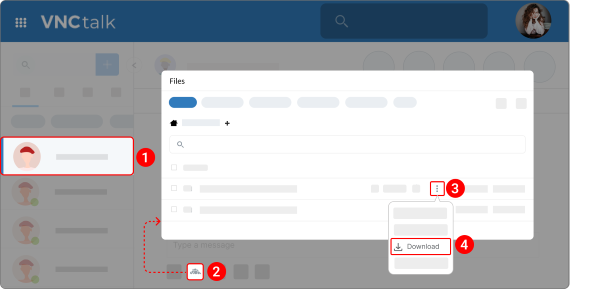 .
. - Preview a result: Hover over it and click the kebab menu icon
 . From the drop-down menu, select File preview.
. From the drop-down menu, select File preview. - Send a result to a chat: Hover over it and click the kebab menu icon
 . From the drop-down menu, select Send to. In the Send to box that opens, select or search for a chat you want to send the file and click it.
. From the drop-down menu, select Send to. In the Send to box that opens, select or search for a chat you want to send the file and click it. - Email a result to a friend: Hover over it and click the kebab menu icon
 . From the drop-down menu, select Email to a friend. In the Email to friend box that opens, fill in the fields and then click Send.
. From the drop-down menu, select Email to a friend. In the Email to friend box that opens, fill in the fields and then click Send.
Change the view of files¶
Files can be displayed in two ways - list or tiles. To change the view of files:
- Open a chat.
- Click a chat drop-down menu and select Files.
- Click the Files tab.
-
Click
 or
or  to change to the view you want to see.
to change to the view you want to see.- Tiles. Displays medium-sized icons of the files with their names, the date when they were sent, and who sent them.
- List. Displays small icons of the files with their names, the date when they were sent, and who sent them.
File preview¶
VNCtalk supports the following file types when previewing:
- Images files
- Video files
- Text documents
Preview a text document¶
You can see the contents of a text document without opening it in a new tab. To quickly preview a file, click it. A preview window will open.
Preview a media file¶
Media files are opened in a media previewer. You can click the left and right arrows to navigate through all files shared in the respective chat. Zoom is supported. The action menu allows forwarding media to a different chat, downloading it, or sending it to the ownCloud.
Forward a media file¶
- Click an image/ video to open it.
- In the top menu, click the forward icon
 .
. - Search for or select a chat you want to forward an image/ video to and click it.
Download a media file¶
- Click an image/ video to open it.
- In the top menu, click the download icon
 .
. - You can also right-click the image/ video and select Download.
Copy a media file¶
- Click an image/ video to open it.
- In the top menu, click the copy to clipboard icon
 . It will copy the media link to a clipboard. You can now paste the copied link to another chat and send it.
. It will copy the media link to a clipboard. You can now paste the copied link to another chat and send it. - You can also copy an actual image to a clipboard - not a link. To do that, right-click the image and select Copy to clipboard. You'll see the notification stating Image copied to clipboard. You can now paste the copied image to another chat using Ctrl/ Command + V.
Send a media file to ownCloud¶
You can send an image/ video to ownCloud within the media previewer.
- Click an image/ video to open it.
- In the top menu, click the ownCloud icon
 .
. - Select a folder where you want to send your media or click Create a folder if you want to create a new one.
- Click Send.
Email a media file to a friend¶
- Click an image/ video to open it.
- In the top menu, click the kebab menu icon
 and then Email to a friend.
and then Email to a friend. - Enter an email address in the field.
- Click Send.
Contacts¶
View contact information¶
Every contact in VNCtalk has a profile where you can view all available data about that person. You can also connect with a contact through video/ audio calls, send a message, open a form to compose an email or create a task for them.
There are 2 ways to view a contact's profile.
Way 1. From the list of contacts.
- Click the notebook icon
 next to your profile image.
next to your profile image. - Go to the Contacts tab.
- Search for a required user from the list or use the search field for it.
- Click the kebab menu icon
 next to the required contact.
next to the required contact. - Select Profile from the dropdown menu.
Way 2. Using the Action wheel.
- Click the notebook icon
 next to your profile image.
next to your profile image. - Go to the Contacts tab.
- Search for a required user from the list or use the search field for it.
- Click the user's avatar icon and click the avatar agian.
Buttons (1) that launch some actions in a corresponding VNC product:
- Make a voice or video call to the user.
- Start a chat.
- Compose a new email.
- Create a ticket/ task for a user.
A user's profile displays general information about your contact (2):
- Profile. See the user's full name, email, role, timezone, and language.
- HR data. See the user's gender, marital status, engagement type, week availability, and payment mode.
- Activity. Monitor chat and email activity.
You can also customize chat settings, work with files and view account details (3). Click the down arrow next to Activity and select one of the following options:
- Settings. Enable/ disable OMEMO Encryption and clear chat history.
- Files. A collection of all the images, videos, docs, voice messages, and saved meetings.
- Account. See the user's profile name, security encryption type, projects, and more.
Compose an email for a contact¶
- Click the notebook icon
 next to your profile image.
next to your profile image. - Go to the Contacts tab.
- Search for a required user from the list or use the search field for it.
- Click the user's avatar and then the envelope icon
 .
.
You should be redirected to VNCmail.
Create a ticket for a contact¶
You can create a task for a user in case the user has the subscription for VNCproject.
- Click the notebook icon
 next to your profile image.
next to your profile image. - Go to the Contacts tab.
- Search for a required user from the list or use the search field for it.
- Click the user's avatar and then the ticket icon
 .
.
You should be redirected to VNCproject.
Create a task for a contact¶
You can create a ticket for a user in case the user has the subscription for VNCtask.
- Click the notebook icon
 next to your profile image.
next to your profile image. - Go to the Contacts tab.
- Search for a required user from the list or use the search field for it.
- Click the user's avatar and then the task icon
 .
.
You should be redirected to VNCtask.
Block/ unblock a contact in a chat¶
There are 3 ways to block a contact.
After you block a contact, you should see the following icon ![]() on the blocked contact's avatar.
on the blocked contact's avatar.
Way 1. Using the "Block user" option in a chat
- Open a chat.
- Click a chat drop-down menu and then Block user.
- To unblock a user, open a chat, click the chat drop-down menu again and then Unblock user.
Way 2. Using the kebab menu next to a chat
- Hover the pointer over a chat with a user you want to block and click the kebab menu icon
 .
. - Click Block user.
- To unblock a user, hover the pointer over a required chat and click the kebab menu icon again and then Unblock user.
Way 3. From the contact list
- Click the notebook icon
 next to your profile image.
next to your profile image. - Go to the Contacts tab.
- Search for a required user from the list or use the search field for it.
- Click the kebab menu icon
 next to the required contact.
next to the required contact. - Select Block user from the dropdown menu.
All blocked users are added to the "Blocked" list. To access the list:
- Click the notebook icon
 .
. - Go to the Contacts tab.
- Click the Blocked chip.
- To unblock a user, click the lock button
 next to a required user.
next to a required user.
Add a contact to the "Favorite" list¶
There are 2 ways to add a contact to the "Favorite" list.
Way 1. Using the kebab menu next to a chat
- Hover the pointer over a chat with a user you want to add to the "Favorite" list and click the kebab menu icon
 .
. - Click Add to Favorites.
- To remove a user from the "Favorite" list, hover the pointer over a required chat and click the kebab menu icon again and then Remove from Favorites.
Way 2. From the contact list
- Click the notebook icon
 next to the Profile icon.
next to the Profile icon. - Go to the Contacts tab.
- Search for a required user from the list or use the search field for it.
- Click the kebab menu icon
 next to the required contact.
next to the required contact. - Select Add to Favorites from the dropdown menu.
A user, marked as "favorite", is added to the "Favorite" list. To access the list:
- Click the notebook icon
 next to the Profile icon.
next to the Profile icon. - Go to the Contacts tab.
- Click the Favorites chip.
- To remove a user from the "Favorite" list, click the star button
 next to a required user.
next to a required user.
ownCloud¶
Currently you can search, view, download, and share your ownCloud files and folders right from VNCtalk.
Share with users and groups¶
You can share the files and folders that you store in your ownCloud with anyone in VNCtalk.
- Open a chat.
- Click the ownCloud icon
 beneath the box where you type your message.
beneath the box where you type your message. - Click the sharing icon
 next to the file you want to send to and select Share with users and groups.
next to the file you want to send to and select Share with users and groups. - Enter the name of the user or a group you want to share with.
- Click Share.
The recipient will need to enter the password to access the shared resource.
Share a public link¶
You can create multiple public links per file or folder. This offers a lot of flexibility for creating different kinds of share links for a single file or folder, such as different passwords, expiry dates, and permissions.
- Open a chat.
- Click the ownCloud icon
 beneath the box where you type your message.
beneath the box where you type your message. - Click the sharing icon
 next to the file you want to send to and select Share a public link.
next to the file you want to send to and select Share a public link. - Provide the name in the Link Name field.
-
Set the permission parameters:
- Download / View. Allows recipients to view or download the public link’s contents.
- Download / View / Edit. Allows recipients to view, download, edit, and delete the public link’s contents.
- Download / View / Upload. Allows recipients to view, download and upload the public link’s contents.
- Upload only. Allows users to create a drop folder, which can receive files from multiple recipients without revealing the contents of the folder.
-
Set a password to protect the link.
- Set an expiry date for the link. The public link expires at the end of the specified date.
- Click Create.
- Now that the share is created and copied to the clipboard, you can manually paste the link to send it.
-
Public link shares are marked with the Shared overlay. Un-shared files/ folders are blank.
Access a public link info¶
This shows details about public links (if they have been created) such as their names, share permissions, and sharing status.
- Open a chat.
- Click the ownCloud icon
 beneath the box where you type your message.
beneath the box where you type your message. - Click the kebab menu icon
 and select Details.
and select Details.
From here, you can also edit, copy, or delete your public link shares.
Edit a public link¶
You can change any of the properties of a public link:
- From the Files box, click the kebab menu icon
 next to the file shared.
next to the file shared. - Click Details.
- Click the kebab menu icon
 next to the public link you want to edit and then Edit.
next to the public link you want to edit and then Edit. -
Rename a file.
- When you rename a public link, it only renames your version; no other users see the new public link name.
-
Change public link permissions.
- Protect a public link with a password.
- Set, adjust or remove the expiration date.
- Click Update.
Copy a public link¶
- From the Files box, click the kebab menu icon
 next to the file shared.
next to the file shared. - Click Details.
- Click the kebab menu icon
 next to the public link you want to copy and then Copy to clipboard.
next to the public link you want to copy and then Copy to clipboard.
Delete a publiс link¶
It's worth noting that you don’t delete a public link. Rather what you do is remove the access of users with whom it’s already been shared with.
- From the Files box, click the kebab menu icon
 next to the file shared.
next to the file shared. - Click Details.
- Click the kebab menu icon
 next to the public link you want to delete and then Delete.
next to the public link you want to delete and then Delete.
To do that, the user should no longer have access to the public link you shared earlier.
Send a file to VNCtalk¶
- Open a chat.
- Click the ownCloud icon
 beneath the box where you type your message.
beneath the box where you type your message. - Click the sharing icon
 next to the file you want to send to and select Send to VNCtalk.
next to the file you want to send to and select Send to VNCtalk. - Select a required user from the list or search for them using the search field.
Mark a file as a favorite¶
- Click the star to the right of the sharing icon to mark it as a favorite.
- You can quickly find all of your favorites with the Favorites filter.
- To unmark a file/ folder as a favorite, click the star icon again.
Rename an ownCloud file/ folder¶
- Open a chat.
- Click the ownCloud icon
 beneath the box where you type your message.
beneath the box where you type your message. - Click the kebab menu icon and select Rename. The file’s current name will be displayed in an editable text box.
- Change the name and click the checkmark icon. If you don’t want to rename it, click
 , and the file name will be left as is.
, and the file name will be left as is.
Download an ownCloud file/ folder¶
- Open a chat.
- Click the ownCloud icon
 beneath the box where you type your message.
beneath the box where you type your message. - Click the kebab menu icon and select Download.
Another way is to check the box next to a file/ folder you want to upload and then click  . In that way, you can download multiple files at once.
. In that way, you can download multiple files at once.
Delete an ownCloud file/ folder¶
- Open a chat.
- Click the ownCloud icon
 beneath the box where you type your message.
beneath the box where you type your message. - Click the kebab menu icon and select Delete.
Another way is to check the box next to a file/ folder you want to delete and then click ![]() . In that way, you can delete multiple files at once.
. In that way, you can delete multiple files at once.
Create an ownCloud folder¶
- Open a chat.
- Click the ownCloud icon
 beneath the box where you type your message.
beneath the box where you type your message. - Click the plus icon in the navigation bar and select New folder.
Upload a file to ownCloud¶
You can send files from a computer to ownCloud without leaving VNCtalk.
- Open a chat.
- Click the ownCloud icon
 beneath the box where you type your message.
beneath the box where you type your message. - Click the plus icon in the navigation bar and then Upload file.
- Select a file from your device and click Open.
After that, you should see the notification stating File(s) has been uploaded.
VNCpad¶
The VNCpad allows you to add one or more pads to write on, for example for notes during an online meeting, and has a text editor with basic text formatting options like bold, italic, underlined and strikethrough text, lists with numbers or bullet points and indent text. In addition, you can add a table for organizing information.
VNCpad also highlights every participant‘s contribution to the VNCpad in a different color and in real-time. These colors can be removed when the document is finished.
Create a VNCpad in a chat¶
- Open a chat.
-
Enter the document name.
- Click CREATE.
After you create the VNCpad, the following icon will appear on a chat, so all participants will be aware of it.
Rename a VNCpad in a chat¶
- Open a chat.
- Click the VNCpad icon
 .
. - Click the down arrow icon
 on a required pad.
on a required pad. - Select Rename pad from the dropdown menu.
- Enter a required name.
- Click UPDATE.
Delete a VNCpad in a chat¶
- Open a chat.
- Click the VNCpad icon
 .
. - Click the down arrow icon
 on a required pad.
on a required pad. - Select Delete from the dropdown menu.
Duplicate a VNCpad in a chat¶
This feature is under development.
Survey¶
You can use the survey to make plans and coordinate with your teammates. For example, one member in a group can create a poll, and the others can vote on ideas and give feedback.
Create a survey¶
- Open a chat.
- Click the survey icon
 and then Create survey.
and then Create survey. -
Choose one of the following options:
- Single input. The short (one-line) question allows you to collect short open-ended answers from respondents.
- Checkbox. The question with checkboxes allows you to collect multiple answers with a single question.
- Radiogroup. The question with radio buttons is a multiple choice question with the ability to select any one of the response options. Radio buttons are used for single select type questions.
-
Enter the question text.
- Click Required to make the survey question required.
- Configure settings by clicking Settings at the bottom.
- Give a name to a survey.
- Set an expiry date for the survey. The survey expires at the end of the specified day.
- Check the box next to Hide the voter's name to make the survey anonymous.
- Click Publish.
Preview survey design¶
Before you publish your survey, preview your survey design to see what your survey will look like to respondents. There is no possibility of editing a survey published, so it's helpful to edit your survey design before collecting responses.
Once the survey is created, click the Preview section and take your survey.
Move a question¶
You can move a question to another position or page in the survey.
- Click the question.
- Hover the pointer over the following icon
 .
. - Drag the question to the desired position in the survey and drop it into place.
Copy a question¶
Copying a question will create a duplicate version of the question in the same survey. All options will carry over to the copied version.
- On the Designer section, hover over the question you want to copy.
- Click Duplicate.
Delete a question¶
After deleting, you cannot restore the question.
- On the Designer section, hover over the question you want to delete.
- Click Delete.
Make a question required¶
You can make any question in your survey required so that survey takers must answer it before submitting the page. By default, required questions are marked by an asterisk (*).
If people don't answer a required question, they will not be able to continue to the next page of the survey until they answer the question within the requirements. You can customize the error message that they see if they leave a required question blank.
- Click the Designer section.
- Select a question to edit it.
- Click Settings > General.
- Check the box next to Required.
- (Optional) Customize the error message by navigating to Validation and filling in the "Required" error message field.
Change the question layout¶
You can change the position or layout of questions on a page.
To adjust the question layout:
- Click the Designer section.
- Select a question to edit it.
- Click Settings > Layout.
- Configure the options as needed.
The question layout options vary depending on the question type.
- Question Placement. You can choose the question that appears directly below the previous question by checking the box next to Display a question on a new line.
- Question number. You can hide the question number.
- Panel expand state. You can choose from the following options: Inherit, Collapsed, Expanded*.
- Title location.
- Description location.
- Indents. Add extra padding to the left of the question.
- Width. You can set a fixed pixel width that will remain fixed regardless of the page width.
- **Input size. ** (You can change the input size on the short answer question questions) You can determine how many characters the respondent can enter in the field.
- Column count. (You can change the number of columns on the questions with checkboxes and radio buttons) You can determine how many columns of answers will be displayed in the answer field.
Create a multiple-page survey¶
You can split your survey into multiple pages to help organize and break up a long list of questions.
You can add pages in an existing survey, and then move the questions up or down accordingly on the page. If you're creating a new survey, you can add pages while adding questions.
Add a page¶
There are 2 ways to add the page to the survey.
Way 1. From the "Designer" tab
- Click the Designer section.
- Click Add question.
- A new page will be added to the survey.
- Enter the page name. You can also enter an optional description for it.
- Add new questions to the page, or move existing questions to the page as required.
Way 2. From the "Settings" panel
- Click the Designer section.
- In the top right corner, click the settings icon.
- From the Settings panel, click Pages.
- Under the Pages section, click the plus icon.
Manage a page¶
After adding the required pages to your survey, you can duplicate, remove, and configure page settings.
- Click the Designer section.
-
Hover the pointer over the page and click it to see the following options:
- Duplicate page. You can create a copy of the page and its questions.
- Remove page. You can remove the page from the survey.
Configure page settings¶
- Click the Designer section.
- Hover the pointer over the page.
-
Click Settings. The settings sidebar will open and you will see the following option:
- General. You can edit page info such as name, title, and description. You can also make the page visible and read-only and set a time limit to finish the page.
- Logic. You can use page logic to conditionally show groups of questions based on a previous answer. Instead of going through the steps for setting up logic on question after question, you can move all questions with the same logic rules to a single page and set up the logic on the page.
- Layout. You can customize question title location, element order on the page, and navigation buttons visibility.
View survey results¶
You can view and analyze your results at any time. Here you can see summaries of every survey question, browse individual responses, compare, view, and download your results for an in-depth analysis.
- Open a chat.
- Click the survey icon
 .
. - Click the kebab menu icon
 next to the survey you want to view and select View results.
next to the survey you want to view and select View results. - You will see a graphical representation of the responses. Depending on the question type you used in your survey, you will see different visualizations to best represent your survey responses.
Change display of text responses¶
- Open a chat.
- Click the survey icon
 .
. - Click the kebab menu icon
 next to the survey you want to view and select View results.
next to the survey you want to view and select View results. - Select a question with text responses.
-
In the upper left corner, click the drop-down menu and select one of the following options:
- Wordcloud is a visual representation of the most common words and phrases from your open-ended responses.
- Text in table displays the list of frequent words and the frequency at which these words appear.
Change display of multiple choice responses¶
- Open a chat.
- Click the survey icon
 .
. - Click the kebab menu icon
 next to the survey you want to view and select View results.
next to the survey you want to view and select View results. - Select a question with multiple choice responses.
-
Click the drop-down menu and select one of the following options:
- Bar: Responses will be displayed as vertical bar graphs. The length of these bars is proportional to the values they represent.
- Pie: Responses will be displayed as a circle that is divided into areas, or slices. Each slice is proportional to the quantity it represents.
- Doughnut: Responses will be displayed as a Pie Chart with an area of the center cut out.
- Scatters: Answers will be displayed as a set of data in which the values of pairs of variables are plotted on a coordinate system.
-
(If the Bar view is selected) To change the response display order, click the drop-down menu and select one of the following options:
- Default: Response options will be displayed in the same order as set by the user.
- Ascending: Response options will be sorted in ascending order alphabetically.
- Descending: Response options will be sorted in descending order alphabetically.
View survey voters¶
- Open a chat.
- Click the survey icon
 .
. - Click the kebab menu icon
 next to the survey you want to view and select View voters.
next to the survey you want to view and select View voters.
Delete a survey¶
You can delete a survey that you don't need anymore. The deletion of a survey is permanent and can't be reverted.
- Open a chat.
- Click the survey icon
 .
. - Click the kebab menu icon
 next to the survey you want to delete.
next to the survey you want to delete. - Select Delete.
Survey settings¶
VNCtalk allows you to set up various survey settings like survey language, navigation buttons location, survey structure, and logic, ensuring responses are anonymous, and more.
General settings¶
General settings allow you to customize survey language, cookie name, and width mode, and make the survey editable or read-only.
- Changing your survey language switches certain default survey text — like navigation buttons — to another language. It does not translate any text you have provided — i.e. the question text and answer options. You must translate the questions and answer options into the relevant language yourself.
- Cookies prevent users from filling out the same survey twice.
To customize general settings:
- Open a chat.
- Click the survey icon
 and then Create a survey or the plus icon if you have created the survey before within this chat.
and then Create a survey or the plus icon if you have created the survey before within this chat. - In the Designer tab, click the settings icon
 and then General.
and then General. - Customize your settings.
- Click the arrow icon to hide the Survey Settings panel.
- Click the Preview tab to preview your choice.
Navigation settings¶
People taking your survey can use these buttons to navigate through a survey.
Navigation settings allow you to edit the button text, show or hide the buttons, customize the button location, and more.
To customize navigation settings:
- Open a chat.
- Click the survey icon
 and then Create a survey or the plus icon if you have created the survey before within this chat.
and then Create a survey or the plus icon if you have created the survey before within this chat. - In the Designer tab, click the settings icon
 and then Navigation.
and then Navigation. - Customize your settings.
- Click the arrow icon to hide the Survey Settings panel.
- Click the Preview tab to preview your choice.
Customize buttons¶
You can edit the text for the following buttons:
- Previous page button
- Next page button
- Complete survey button
- Preview answers button
- Edit answer button
- Start survey button
To edit the button text:
- From the Settings panel, click Navigation.
- Click the field of the button's name you want to edit.
- Enter the preferred text.
Customize buttons location¶
You can change the buttons location to Top, Bottom, and Both. You can also hide buttons at all.
- From the Settings panel, click the Navigation section.
- Under the Navigation buttons location section, click the preferred option.
You can allow or prevent respondents from editing their responses on previous pages. This setting controls whether or not the Previous button is shown on each page in your survey.
- To hide the Previous button, uncheck the box next to Show the Previous Page button — don't allow respondents to go back and change existing responses.
- To show the Previous button, check the box next to Show the Previous Page button — allow respondents to go back to previous pages in the survey and update existing responses.
Customize progress bar location¶
With a progress bar (completed pages), participants can see how far along they are in the survey. It gives participants an idea of both how far they’ve come and how much further they have to go.
You can change the progress bar location to Top, Bottom, and Both. You can also hide the progress bar.
- From the Settings panel, click the Navigation section.
- Under the Progress bar location section, click the preferred option.
Question settings¶
You can use the Question tab to customize your question: customize the question title location, change the required symbol or numbering style, and set the character limit in open-ended answers.
To customize question settings:
- Open a chat.
- Click the survey icon
 and then Create a survey or the plus icon if you have created the survey before within this chat.
and then Create a survey or the plus icon if you have created the survey before within this chat. - In the Designer tab, click the settings icon
 and then Question.
and then Question. - Customize your settings.
- Click the arrow icon to hide the Survey Settings panel.
- Click the Preview tab to preview your choice.
Customize question title location¶
You can change the question title location to Top, Bottom, and Left.
- From the Settings panel, click Question.
- Under the Question title location section, click the preferred option.
Change required symbol¶
You can make any question in your survey required so that survey takers must answer it before submitting the page. By default, required questions are marked by an asterisk (*).
You can change the required symbol.
- From the Settings panel, click Question.
- In the Required symbol field, enter the preferred option.
Change the numbering style¶
You can specify the numbering style that you want. Choices include Arabic numerals, uppercase and lowercase Roman numerals, uppercase and lowercase alphabet letters. You can also choose no numbers at all, killing the sequential numbering.
- From the Settings panel, click Question.
- In the Start index (number or letter) field, enter the preferred option.
Customize error message location¶
You can change the error message location to Top or Bottom.
- From the Settings panel, click Question.
- Under the Error message location section, click the preferred option.
Change the order of survey questions¶
You can change the order of any questions in your survey. You can apply it to all questions on the page/ pages.
- From the Settings panel, click Question.
-
Under the Element order on the page section, choose from the following options:
- Random. Questions will appear in random order.
- Initial. Questions will appear in the order you've created the questions.
Set maximum answer length¶
The answer question type allows your respondents to write open-ended answers in a textbox. You can set the character limit.
- From the Settings panel, click Question.
- In the Maximum answer length (in characters) field, enter the preferred option.
Pages settings¶
You can use the Pages tab to customize the survey pages: add a page or remove a page, change the page location and title, and determine whether to show or hide the page title/ number.
To customize page settings:
- Open a chat.
- Click the survey icon
 and then Create a survey or the plus icon if you have created the survey before within this chat.
and then Create a survey or the plus icon if you have created the survey before within this chat. - In the Designer tab, click the settings icon
 and then Pages.
and then Pages. - Customize your settings.
- Click the arrow icon to hide the Survey Settings panel.
- Click the Preview tab to preview your choice.
Add page title¶
You can add page titles to the different pages in your survey to keep it organized.
- From the Settings panel, click Pages.
- Under the Pages section, click the name of the page and make your changes.
Reorder pages¶
You can move a page to another position in the survey.
- From the Settings panel, click Pages.
- Using the icon with three horizontal lines, click, hold and drag the pages into their new order.
Remove a page¶
If you no longer need a page in the survey, you can delete it. When deleting, you delete all questions currently on that page.
- From the Settings panel, click Pages.
- Under the Pages section, click the trash bin icon next to the page you want to delete.
Show or hide page titles/ numbers¶
You can hide the titles and page numbers in your survey.
- From the Settings panel, click Pages.
- Deselect the Show page titles or Show page numbers boxes as required.
Timer settings¶
You can set up a countdown timer to your survey and manage the time your respondents spend on your survey or on the page of your survey. This feature is useful when you need to conduct a quiz or an online test.
There are 2 types of timers in VNCtalk:
- Survey timer
- Page timer
To customize timer settings:
- Open a chat.
- Click the survey icon
 and then Create a survey or the plus icon if you have created the survey before within this chat.
and then Create a survey or the plus icon if you have created the survey before within this chat. - In the Designer tab, click the settings icon
 and then Timer/Quiz.
and then Timer/Quiz. - Customize your settings.
- Click the arrow icon to hide the Survey Settings panel.
- Click the Preview tab to preview your choice.
Add a survey timer¶
A survey timer lets your respondent know how much time they have left to complete the entire survey. You can set up a maximum time limit to answer all questions in your survey. When a timer is set, the respondents will have to complete the survey within the time limit and if they fail to do so, the responses they have entered until then will be automatically submitted.
- From the Settings panel, click Timer/ Quiz.
- In the Time limit to finish the survey, enter the maximum time duration for the survey.
- Under the Timer location section, choose the preferred option.
- Under the Timer mode section, choose Survey.
Add a page timer¶
You can use the page timer to make sure your respondents only spend the required time on the pages of your survey. When a page timer is set, the respondents will have to complete the page within the time limit; if they fail to do so, the responses they have entered until then on the page will be automatically submitted, and the survey will load the following page.
- From the Settings panel, click Timer/ Quiz.
- In the Time limit to finish one page, enter the maximum time duration for the survey.
- Under the Timer location section, choose the preferred option.
- Under the Timer mode section, choose Survey.
Screenshare session¶
You can start screen sharing directly in a chat without making a call first.
Screen sharing involves sharing access to your computer screen, desktop, or other content during a meeting. Other users are then able to see your screen and watch your activity in real time – it works well for online presentations or meetings.
Start a screen share session in a chat¶
The process for sharing your screen in group chats is the same as in one-on-one chats.
When you start a screen share session in a group chat, select whether you want to start a screen share session with all users of the group chat or a particular user.
If you want to start a screen share session with a particular user, click the Selected only tab. Once done, select a required user and click Start.
- Open a chat.
- In the upper right corner, click the monitor icon
 .
. -
Select the appropriate option:
- Your entire screen: Share everything on your screen.
- Window: Share just one window.
- Tab: Share one open tab.
-
Click Share.
- The other participants in the chat will receive a notification asking them to accept your screen share. Once they do, they'll be able to see your screen.
- To stop sharing your screen, click the stop button.
Start a screen share session with an external user¶
You can start a screen share session with an external user, who does not belong to your organization.
- Click the plus icon and choose Screenshare.
- Enter the external user's email address in the field and click Enter.
- Click the arrow button
 located at the bottom of the modal window. Once done, you should see the corresponding chat in the chats list for the screen share session.
located at the bottom of the modal window. Once done, you should see the corresponding chat in the chats list for the screen share session. -
Select the appropriate option:
- Your entire screen: Share everything on your screen.
- Window: Share just one window.
- Tab: Share one open tab.
-
Click Share.
- The external user will receive a notification asking them to join a video meeting. Once they click the Join the Meeting button in the email, they'll be able to see your screen.
Audio/ video calls¶
Start an audio/ video call¶
There are 5 methods to start an audio or video call:
Way 1. Using the handset/ camera icon in a chat.
Way 2. Using the handset/ camera icon in a group chat.
- Open a required group chat.
- In the chat header, click the handset icon
 or the camera icon
or the camera icon  .
. -
Select whether you want to start a call with all users of the group chat or a particular user.
- If you want to start a call with a particular user, click the Selected only tab and select a required user.
-
Click Start.
Way 3. Using the kebab menu next to a chat.
- In the left-side column where all your conversations are shown, hover the pointer over a required chat and click the kebab menu icon
 that appears in the upper right corner.
that appears in the upper right corner. - Select ** Voice call or Video call** from the drop-down menu.
Way 4. Using the kebab menu next to a group chat.
- In the left-side column where all your conversations are shown, hover the pointer over a required chat.
- Click the kebab menu icon
 that appears in the upper right corner.
that appears in the upper right corner. - Select ** Voice call or Video call** from the drop-down menu.
- Select whether you want to start a call with all users of the group chat or a particular user.
- Click Start.
Way 5. From the contact list.
- Click the notebook icon
 located in the top-right corner.
located in the top-right corner. - Go to the Contacts tab.
- Search for a required user from the list or use the search field for it.
- Click the kebab menu icon
 next to the required contact.
next to the required contact. - Select the Voice call or Video call menu option that opens.
- Alternatively, you can click the user's avatar and then click the handset
 or camera
or camera  icon.
icon.
Answer an audio/ video call¶
If you receive an incoming call, do one of the following:
- Accept an incoming call/ accept a video call as an audio call: Click
 .
. - Accept a video call with the enabled camera: Click
 .
. - Decline a call: Click
 .
.
If you miss an audio call, you should see the following notification in a chat/group chat:
Use a quick response¶
A quick response is a short message that you can send when rejecting a call. The default quick responses let people know you can't answer right now and how to contact you next.
When someone calls you, you see the incoming call screen. If you want to reject the call and send a quick response, do the following:
- Click the kebab menu icon in the upper right corner.
-
By default, you get four quick response text message samples. Click the response you want to send:
- Can't talk. What's up?
- I'll call you right back.
- I'll call you later.
- Can't talk now. Call me later?
-
You also have the option to mute sound or block the user.
Record an audio/ video call¶
To record a video/audio call, follow the instructions from the "Record a video meeting" subsection.
Rejoin an active audio/ video call¶
To rejoin an active audio/video call, follow the instructions from the "Join a video meeting" subsection.
Switch to floating video view¶
The floating video window allows you to minimize the main video window while keeping the video on top of other applications you have open. You can move the window around your screen as needed.
- Click the chats icon
 in the lower right corner.
in the lower right corner. - Once in a mini-window view, you can change the video window state from rectangle to circle. To do that click the icon
 at the top right. Click the icon again to return to the previous state.
at the top right. Click the icon again to return to the previous state. - While in this mode, you can also easily mute/ unmute yourself or turn on/ off your video by clicking
 and
and  buttons accordingly.
buttons accordingly. - Click the kebab menu icon
 to add participants, start recording, mute all, or turn off all cameras.
to add participants, start recording, mute all, or turn off all cameras. - Hover your mouse pointer over the floating video window. Holding down the left mouse button on the following icon
 allows you to move the window around the screen.
allows you to move the window around the screen. - Double-click on an empty area of the floating video window to return to the full window.
Expand to full screen during an audio/ video call¶
You can switch the layout to full-screen mode during a video call. You can do that by clicking the kebab menu icon in a tile or using the Participant icon.
Way 1. Clicking the kebab menu icon in a tile.
- While you are in a video call, hover the pointer over the participant tile and click the kebab menu icon
 that appears in the upper right corner.
that appears in the upper right corner. - From the drop-down menu that opens, select Expand to full screen. The video stream will expand to full screen.
- You can exit the full screen by clicking
 in the upper left corner.
in the upper left corner.
Way 2. Using the Participant icon.
- In the upper right corner, click the participant icon
 .
. - Click the kebab menu icon
 next to the user.
next to the user. - Select the Expand to full screen menu option that appears.
Mute/ unmute a user for me during an audio/ video call¶
You have an option to mute another participant just for yourself. You can do that by clicking the kebab menu icon in a tile or using the Participant icon.
Way 1. Clicking the kebab menu icon in a tile.
- While you are in a video call, hover the pointer over the participant tile and click the kebab menu icon
 that appears in the upper right corner.
that appears in the upper right corner. - From the drop-down menu that opens, select Mute for me.
To unmute the partisipant:
- Hover the pointer over one of the participants and click the kebab menu icon
 that appears in the upper right corner.
that appears in the upper right corner. - From the drop-down menu that opens, select Unmute for me.
Way 2. Using the Participant icon.
- Click the participant icon
 at the top right.
at the top right. - Click the kebab menu icon
 next to the user you want to mute.
next to the user you want to mute. - Select Mute for me menu option that appears.
Send a private message to a user during an audio/ video call¶
You can send a private message to an individual participant during an audio/ video call.
- While you are in a video call, hover the pointer over the participant tile and click the kebab menu icon
 that appears in the upper right corner.
that appears in the upper right corner. - From the drop-down menu that opens, select Send a message.
- Enter a message and click Send.
The user can answer your message immediately by clicking Reply.
Send an instant message to other users within a call¶
You can send messages, pictures, files, and even voice messages during any call to other call participants. In that case, messages are visible to everyone on the call.
- While you are in a video call, click the mini chat icon
 in the lower right corner.
in the lower right corner. -
On the right, select who you want to send the message to:
-
Enter your message or send pictures.
- Press Enter to send your message.
Channels¶
As for channels instructions, refer to the following documentation:
Broadcasts¶
VNCtalk Broadcast is a fast way to inform individual participants or defined groups and recipient lists about events of any kind. You can just write a broadcast message and everyone in the selected group will be informed immediately.
If someone wants to answer your broadcast or has a question, a 1:1 chat with the creator of the broadcast will automatically be created.
Create a broadcast¶
It is possible to create a broadcast with a minimum of 2 users. Also, you can add group chat participants to a broadcast.
- Click the plus icon and then New broadcast.
- Enter a broadcast name in the Broadcast Title field.
- Search for required participants using the search field or select a required group chat.
- Click the start broadcast button
 .
.
You can check the created broadcast in the Broadcast tab of the left sidebar.
Access broadcast info¶
The instruction to access broadcast info is the same as for a chat. So, refer to the "Access chat info" instruction, but perform the steps with a required broadcast.
Pin a chat in a broadcast¶
The instruction to pin a chat in a broadcast is the same as for a chat. So, refer to the "Pin a chat" instruction, but perform the steps with a required chat in a broadcast.
Disable/ enable notifications in a broadcast¶
The instruction to disable/enable notifications in a broadcast is the same as for a chat. So, refer to the "Disable/ enable notifications in a chat" instruction, but perform the steps with a required broadcast.
Enable/ disable E2E encryption in a chat¶
The instruction to disable/enable E2E encryption in a broadcast is the same as for a chat. So, refer to the "Enable/ disable E2E encryption in a chat" instruction, but perform the steps with a required broadcast.
Change chat message storage settings in a broadcast¶
The instruction to change chat message storage in a broadcast is the same as for a chat. So, refer to the "Change chat message storage settings" instruction, but perform the steps with a required broadcast.
Add a broadcast to the "Favorite" list¶
The instruction to add a broadcast to the "Favorite" list is the same as for a group chat. So, refer to the "Add a group chat to the "Favorite" list" instruction, but perform the steps with a required broadcast.
Delete a broadcast¶
The instruction to delete a broadcast is the same as for a chat. So, refer to the "Delete an active chat" instruction, but perform the steps with a required broadcast.
Search in a broadcast¶
The instruction to search in a broadcast is the same as for a chat. So, refer to the "Search in a chat" instruction, but perform the steps with a required broadcast.
Share a file in a broadcast¶
The instruction to share a file in a broadcast is the same as for a chat. So, refer to the "Share a file" instruction, but perform the steps with a required broadcast.
Video meetings¶
Video meeting roles and permissions¶
Every user has a role, each with its level of permissions and access in a video meeting.
There are three channel roles: Moderator, Participant, and Audience. Their privileges are as follows:
- Moderator: The user who started a video meeting. The owner has the most editing privileges in the video meeting, including adding participants and assigning them roles. There can be only one channel owner. The star icon indicates a moderator. A user with this badge
 is a Moderator.
is a Moderator. - Participant: Someone who has joined the video meeting and has been given certain editing privileges. There can be multiple video meeting participants. A user with this badge
 is a Participant.
is a Participant. - Audience: Someone who has joined the video meeting. A user with the eye badge
 is an Audience.
is an Audience.
The following table outlines what actions the Moderator, Participant, and Audience can perform in a video meeting.
| Action | Moderator | Participant | Audience |
|---|---|---|---|
| Share the screen | Yes | Yes | No |
| Create a whiteboard | Yes | No | No |
| Start a broadcast | Yes | No | No |
| Send messages to participants | Yes | Yes | Yes |
| Change participants' roles | Yes | No | No |
| Remove participants from a video meeting/ group | Yes | No | No |
| Add participants with a particular role | Yes | No | No |
| Mute/ unmute participants | Yes | No | No |
| Raise a hand | Yes | Yes | No |
| Add participants without a role | Yes | Yes | Yes |
| Mute/ unmute participants for themself | Yes | Yes | Yes |
Assign a role before a meeting¶
You can assign a role while scheduling a meeting and adding participants to a video meeting in progress. Refer to the "Schedule a video meeting" and "Add participants to a video meeting in progress" subsections, for step-by-step guides.
Change a role during a meeting¶
Only the Moderator can change a role for users in a video meeting.
There are 2 ways to change someone's role while a meeting is in progress.
Way 1. Clicking the arrow icon next to the user's name.
- While in the meeting, click the down arrow
 next to the user for whom you want to change a role.
next to the user for whom you want to change a role. - Select Change role from the dropdown menu.
- Assign a required role.
- Click Change.
Way 2. Using the info icon.
- In the top right corner, click the info icon
 .
. - Click the kebab menu next to a user for whom you want to change a role.
- Select Change role from the dropdown menu.
- The further steps are the same as for the first way of changing a role for a user.
Start a video meeting¶
To create a new meeting and join the meeting directly, do the following:
- Click the plus icon.
- Select Start video meeting to start an instant video meeting.
To rejoin the same meeting anytime, find the meeting chat in your chat list and click Join.
Schedule a video meeting¶
You can schedule a new video meeting from:
Schedule a video meeting from VNCtalk¶
- Click the plus icon.
- Select Schedule meeting.
- Select the meeting date, time, and expected duration.
- Enter a video meeting name.
- Click the avatar icon to add a video meeting image. Hover the pointer over the avatar icon and click Upload. Select an image from your device, crop it, and click Apply.
- Under the Participants section, click the plus icon and assign a required role for participants. Then select the users you want to invite to a meeting and click the Select button.
-
(Optional) Click the down arrow
 next to the Settings, if you want to add a description and tags and set a password for a video meeting. You can also assign a video meeting to the corresponding Multi Conference Board.
next to the Settings, if you want to add a description and tags and set a password for a video meeting. You can also assign a video meeting to the corresponding Multi Conference Board. - Setting a password for the video meeting, all the participants will have to enter this password to access the video meeting. You should provide all the participants with this password.
-
Click Create.
Schedule a video meeting from VNCmail Calendar¶
To start a video meeting from the VNCmail Calendar, you have to switch the "Video Meeting" toggle on. Refer to the "Schedule a video meeting" subsection, for a step-by-step guide.
Add or remove users from a video meeting¶
You can add people to a video meeting in a video meeting before and after the meeting starts.
Every meeting participants will continue to have access to the meeting chat, the recording, and anything else people share in the meeting (like files and meeting notes), even after the meeting ends.
Add users to a video meeting in progress¶
There are 3 ways to add participants to a video meeting in progress.
Way 1. Using the "Add Participants" button in the modal window.
- Click the Add Participants button in the modal window in the bottom left corner.
- Assign a required role for participants — Moderator, Audience, or Participant.
- Search for people you want to add to a meeting and select them.
- Click Update.
They will join a meeting right away.
Way 2. Clicking the info icon.
- In the top right corner, click the info icon
 .
. - Click the Add Participants button.
- The further steps are the same as for the first way of adding participants to a video meeting.
Way 3. Using the down arrow.
-
Select Add participants from the dropdown menu.
- The further steps are the same as for the first way of adding participants to a video meeting.
Way 4. By using a meeting link.
You can also copy the meeting link and send it to anyone you want to meet with, and they can join by clicking it. Just click the copy icon ![]() and paste the link into a message.
and paste the link into a message.
Add users before starting the meeting¶
You can also schedule a meeting and add participants before starting the meeting. Refer to the "Schedule a meeting" section, for a step-by-step guide.
Invite external users to a video meeting¶
You can start a video meeting not only with internal users, who are members of your organization but also with external users, who do not belong to your organization.
- Follow the steps above 1 through 5 to schedule a meeting.
- Under the Participants section, click the plus icon to add users to the video meeting.
- Assign a required role for a user — Moderator, Audience, or Participant.
- Enter the user's email address in the Search field and click the blue arrow icon. The address will appear in a circle if it has been successfully entered as a participant.
- Click Select.
- Click Create.
This will send out an invite to the user with a link to join a video meeting.
Remove a user from a video meeting¶
Only the Moderator can remove users from a video meeting.
There are 2 ways to remove someone from a meeting.
Way 1. Clicking the arrow icon next to the user's name.
- While in the meeting, click the down arrow
 next to the user you want to mute for everyone.
next to the user you want to mute for everyone. - Select Remove from call from the dropdown menu.
The participant will be removed from the meeting and will not be able to join again.
Way 2. Using the info icon.
- Click the info icon
 in the upper right corner.
in the upper right corner. - Click the kebab menu icon
 next to a user you want to remove from a meeting.
next to a user you want to remove from a meeting. - Select Remove from call from the dropdown menu.
Remove a user from a video meeting group¶
Only the Moderator can remove users from a video meeting group.
If you remove a user from a group chat, they will be removed from a video meeting too.
There are 2 ways to remove a user from a video meeting group.
Way 1. Clicking the arrow icon next to the user's name.
- While in the meeting, click the down arrow
 next to the user you want to mute for everyone.
next to the user you want to mute for everyone. - Select Remove from group from the dropdown menu.
Way 2. Using the info icon.
- Click the info icon
 in the upper right corner.
in the upper right corner. - Click the kebab menu icon
 next to a user you want to remove from a video meeting group.
next to a user you want to remove from a video meeting group. - Select Remove from group from the dropdown menu.
Leave a video meeting¶
It doesn't matter who you are, moderator, participant, or audience, leaving the meeting means that you are ending it for everyone.
- On the remote control, click the End Call button
 .
. - Confirm that you want to end a video meeting — click End in the modal window.
Join a video meeting¶
You can join a video meeting from VNCtalk or VNCmail Calendar. You can also join a video meeting if you do not have a VNClagoon account.
Join a video meeting from VNCtalk¶
There are 2 ways to join a video meeting from VNCtalk.
Way 1. Join by link.
- Open a chat.
- Click the link to be taken to the pre-meeting lobby
- Enter your name to join a meeting.
- (Optional) Enter the company's name, role, and password.
- Click Join.
Way 2. Join from chat.
If the meeting has already begun, it appears in your recent chat list.
- Click the Meetings chip.
- Open a chat.
- Click Join at the top of the chat.
Join a video meeting from VNCmail Calendar¶
- Navigate to VNCmail > Calendar.
- Find the meeting you want and click Join.
Join a video meeting as an external user¶
Users who do not have a VNCtalk account can also join a video meeting.
- Before a video meeting is due to start, open the invitation email and click the Join the Meeting button at the bottom.
-
The button will open up a VNCtalk page in your web browser. Select Join in your Browser.
- If prompted, allow access to your microphone and webcam. If you do not do this, other users in the meeting will not be able to see or hear you.
-
You will now join the pre-meeting lobby. Here you can:
-
Enter the name other users in the meeting will see.
- (Optional) Enter the company's name, role, and password.
- Click Join.
If the organizer has not yet started the meeting, you will see the screen below. Otherwise, you will be taken straight into the meeting.
View scheduled/ previous video meetings¶
You can view your scheduled meetings by navigating to Meetings via the left navigation menu, where you will see a list of your upcoming and previous meetings.
Edit a scheduled video meeting¶
Only organizers can modify meetings.
You can make changes to meetings that you have already scheduled from the meeting list sidebar or video meeting chat.
If adding additional participants to the meeting, append new participants to the existing list; removing the original participants from the list will cause them to receive meeting canceled emails.
Way 1. From the meeting list.
- Navigate to Chats > Meetings.
- Hover the pointer over the video meeting you want to edit and click the kebab menu icon
 that appears in the upper right corner.
that appears in the upper right corner. - Select Modify scheduled meeting from the dropdown menu.
- Make your changes.
- Click Create.
Way 2. From the video meeting chat.
- Navigate to Chats > Meetings.
- Open the video meeting chat you want to edit.
- In the chat header, click the down arrow
 .
. - Select Modify scheduled meeting from the dropdown menu.
- The further steps are the same as for the first way of editing a scheduled video meeting.
When you are finished, all the meeting participants will see the notification stating Mia Chesterfield has updated the group photo. An updated meeting invitation is sent out to all the invitees after the changes are saved.
Cancel a scheduled video meeting¶
Only organizers can cancel meetings.
You can cancel scheduled upcoming video meetings if the meeting is not necessary and you want to let the meeting participants know the meeting is canceled. You can do that from the meeting list or the video meeting chat.
Way 1. From the meeting list.
- Navigate to Chats > Meetings.
- Hover the pointer over the video meeting you want to cancel and click the kebab menu icon
 that appears in the upper right corner.
that appears in the upper right corner. - Select Cancel scheduled meeting from the dropdown menu.
- Confirm that you want to cancel the video meeting — click Yes in the modal window.
- Type a message to let the participants know the meeting is canceled. It’s not necessary, but it helps to avoid confusion.
- Click Send.
Way 2. From the video meeting chat.
- Navigate to Chats > Meetings.
- Open the video meeting you want to cancel.
- In the chat header, click the down arrow
 .
. - Select Cancel scheduled meeting from the dropdown menu.
- The further steps are the same as for the first way of canceling a scheduled video meeting.
When you are finished, you should see the notification stating Meeting canceled and the meeting participants receive an email stating that the video meeting has been canceled by the organizer.
Video meeting settings¶
Customize video meeting settings¶
Video meeting settings allow you to customize:
- The top and bottom bars in a video meeting. By default, they are always visible during a video meeting. But you can customize them and they will be visible only if you hover the pointer over them;
- Video quality;
- Enable the pop-up window to confirm that you want to leave a video meeting.
To customize video meeting settings, do the following:
-
While in the meeting, click the down arrow
 next to the meeting name.
next to the meeting name. -
Select Video meeting Settings from the dropdwon menu.
-
From the Behavior of the top/ bottom bar dropdown menu, select one of the following options:
- Always show - if you want the top/ bottom bar to be always visible;
- Show on mouse-over, hide on mouse out - if you want the top/ bottom bar to appear when you hover the pointer over it and to disappear when you remove the pointer.
-
Switch the Show confirmation box when leaving video conference toggle on, if you want to have the pop-up window to confirm that you want to leave a video meeting.
-
From the Select the Video Quality dropdown menu, select one of the following options:
- High Definition and Standard Definition options are appropriate when you do not have issues with the internet connection;
- Low Definition or Low Bandwidth options are appropriate when you have some issues with the internet connection.
-
Click Save.
Customize audio & video settings for a video meeting¶
-
While in the meeting, click the down arrow
 next to the meeting name.
next to the meeting name. -
Select Audio & Video from the dropdown menu.
-
Under the AUDIO section, you can customize the following settings:
- Input — The dropdown menu may suggest the types of input devices in case you have some external headphones connected. For example, if you use a laptop and you do not have some external headphones connected, the laptop microphone will be used for the input sound. In this case, only the Default option is available in the dropdown menu. But if you connect the external headphones, you will be able to select them from the drop-down menu.
- Level — Allows you to check that your sound and microphone work properly.
- Output — The dropdown menu may suggest the types of output devices in case you have some external headphones connected. For example, if you use a laptop and you do not have some external headphones connected, the laptop microphone will be used for the output sound. In this case, only the Default option is available in the dropdown menu. But if you want to use your headphones, you can connect them and select them from the drop-down menu.
-
Under the VIDEO section, you can customize the types of cameras in case you have some external cameras connected. For example, if you use a laptop without an external camera connected, the laptop camera will be used when you have a video call/ meeting. But if you connect some external camera, you will be able to select it from the dropdown menu.
- Click Save.
Customize security options for a video meeting¶
You can protect a video meeting using VNCtalk additional security options. They are:
- Lobby mode — This option is available for both 1:1 and group video meetings. If you enable the option, you will be able to confirm other users' participation in a video meeting;
- Password — This option is available only for group video meetings. If you add a password, other users will have to enter this password while joining a video meeting. In this case, you should share the password with all users before the video meeting begins;
- End-to-End Encryption — This option is experimental and available for both 1:1 and group video meetings. If you enable it, such services as recording, live streaming, and phone participation will be disabled.
If you enable both "Lobby mode" and "Password" options, a user will have 2 options to join a video meeting: get confirmation from the moderator or enter a password. If the user enters the password, they will join the video meeting without the moderator's confirmation."
-
While in the meeting, click the down arrow
 next to the meeting name.
next to the meeting name. -
Select Security options from the dropdown menu.
- If you want to confirm each user's participation in a video meeting - switch on the Enable Lobby toggle.
- If you want to protect a video meeting with a password, click Add password and then enter the password in the appeared field.
- If you want to enable end-to-end encryption - switch the Enable End-to-End Encryption toggle on, but note that some services (such as recording, live streaming, and phone participation) will be disabled.
- Click Save.
Customize a background in a video meeting¶
If you want to change what appears behind you in your video meeting, you can either replace your background entirely with any image you want or use a virtual background template.
-
While in the meeting, click the down arrow
 next to the meeting name.
next to the meeting name. -
Select Video meeting settings from the dropdown menu.
- On the left navigation menu, click Background.
- Click an image to select the desired virtual background.
- To use an image of your own, click the plus icon and then select one to upload from your device.
- Click Save.
Chat during a video meeting¶
Send a broadcast message¶
Only the Moderator can send a broadcast message in a video meeting.
- On the bottom, click the broadcast icon
 .
. - Click the down arrow
 and select the message template.
and select the message template. - If you select Custom message, you should type your message in the appeared field.
- Click Send.
Send a message to everyone¶
You can send messages, pictures, files, and even voice messages during a meeting to other participants. In that case, messages are visible to everyone in the meeting.
Refer to the "Send an instant message to other users within a call" subsection, for a step-by-step guide.
Send a private message¶
There are 2 ways to send a message to an individual participant.
Way 1. Clicking the arrow icon next to the user's name.
- While in the meeting, click the down arrow
 next to the user you want to send a private message.
next to the user you want to send a private message. - Select Send a message from the dropdown menu.
- The quick message dialog will open. Enter a message.
- Click Send.
The user can answer your message immediately by clicking Reply.
Way 2. Using the info icon.
- Click the info icon
 in the upper right corner.
in the upper right corner. - Click the kebab menu next to a user you want to send a message.
- Select Send a message from the dropdown menu.
- The further steps are the same as for the first way of sending a message to an individual participant.
Send a wake-up message¶
Only the Moderator can send "wake up" message to users during a video meeting.
There are 2 ways to send the "wake-up" message to a user during a video meeting.
Way 1. Clicking the arrow icon next to the user's name.
- While in the meeting, click the down arrow
 next to the user you want to send a wake-up message.
next to the user you want to send a wake-up message. - Select the Wake up from the dropdown menu.
The user should receive the notification stating "You have been called to wake up by Mia Chesterfield".
Way 2. Using the info icon.
- Click the info icon
 in the upper right corner.
in the upper right corner. - Click the kebab menu next to a user you want to send a wake-up message.
- Select the Wake up from the dropdown menu.
View people in a video meeting¶
Customize a layout in a video meeting¶
You can customize the video layout preferences during a video meeting. There are 3 available video layouts for your convenience.
- In the bottom left corner, click the customize layout icon
 .
. -
Select one of the following options:
- Grid view. This layout is set by default and shows a grid view of equal-sized images.
- Floating window. Full-screen layout with the option to display the participant you pin. When you pin a participant, they are always visible.
- Stripe. The main image is the active speaker or shared screen. You will see thumbnails of additional participants at the bottom.
Once you have changed a screen layout, you should see the notification stating You have switched to the tile view.
Switch to floating video view¶
The floating video window allows you to minimize the main video window while keeping the video on top of other applications you have open. You can move the window around your screen as needed.
- Click the chat icon
 in the bottom right corner.
in the bottom right corner. - Once in a mini-window view, you can change the video window state from rectangle to circle. To do that click the customize view icon
 at the top right. Click the icon again to return to the previous state.
at the top right. Click the icon again to return to the previous state. - While in this mode, you can also easily mute/ unmute yourself or turn on/ off your video by clicking the microphone button
 and camera button
and camera button  accordingly.
accordingly. - Click the kebab menu icon
 to add participants, start recording, mute all, or turn off all cameras.
to add participants, start recording, mute all, or turn off all cameras. - Hover your mouse pointer over the floating video window. Holding down the left mouse button on the following icon
 allows you to move the window around the screen.
allows you to move the window around the screen. - Double-click on an empty area of the floating video window to return to the full window.
View a participant in full-screen¶
You can switch the layout to full-screen mode during a video call. There are 2 ways to view a participant in full screen.
Way 1. Clicking the arrow icon next to the user's name.
- While in the meeting, click the down arrow
 next to the user you want to view in full screen.
next to the user you want to view in full screen. - Select Full screen from the dropdown menu. The video stream will expand to full screen.
Way 2. Using the info icon.
- Click the info icon
 in the upper right corner.
in the upper right corner. - Click the kebab menu icon
 next to a user you want to view in full screen.
next to a user you want to view in full screen. - Select the Expand to full screen from the dropdown menu.
Pin a participant¶
Only the Moderator can pin/ unpin a user's view to full screen.
There are 2 ways to pin a participant.
Way 1. Clicking the arrow icon next to the user's name.
- While in the meeting, click the down arrow
 next to the user you want to pin.
next to the user you want to pin. - Select Pin to full screen from the dropdown menu. You should see that the user's view is expanded to full screen.
- To unpin a user's view from the full screen, click the info icon
 in the upper right corner. Click the kebab menu icon
in the upper right corner. Click the kebab menu icon  next to the user you want to unpin and then select Unpin to full screen from the dropdown menu.
next to the user you want to unpin and then select Unpin to full screen from the dropdown menu.
Way 2. Using the info icon.
- Click the info icon
 in the upper right corner.
in the upper right corner. - Click the kebab menu icon
 next to a user you want to pin.
next to a user you want to pin. - Select Pin to full screen from the dropdown menu.
Manage audio and video permissions¶
Deactivate all participant microphones or cameras¶
The Moderator can disable the microphone or camera of all the participants, or individuals, at any time during the meeting.
- Click the kebab menu icon
 at the bottom bar.
at the bottom bar. - Select Mute everyone or Deactivate camera for everyone. Attendee mics and cameras will appear disabled.
- (Optional) If later you want to enable everyone's microphone or camera, click the kebab menu icon again and then select Unmute everyone and Allow camera access for everyone.
Deactivate the individual's microphone or camera¶
Only the Moderator can mute/unmute users in a video meeting.
There are 2 ways to mute a participant during a video meeting.
Way 1. Clicking the arrow icon next to the user's name.
- While in the meeting, click the down arrow
 next to the user you want to mute for everyone.
next to the user you want to mute for everyone. - Select Mute for everyone or Turn off the camera from the dropdown menu.
- Confirm that you want to mute the user and click Mute in the modal window.
- (Optional) To unmute a user, click the down arrow
 next to the user you want to unmute and then select Unmute for everyone or Enable camera access.
next to the user you want to unmute and then select Unmute for everyone or Enable camera access.
Way 2. Using the info icon.
- Click the info icon
 in the upper right corner.
in the upper right corner. - Click the kebab menu icon
 next to a user you want to mute.
next to a user you want to mute. - Select Mute for everyone or Turn off the camera from the dropdown menu.
Mute/ unmute a user for me in a video meeting¶
You have an option to mute another participant just for yourself.
- While in the meeting, click the down arrow
 next to the user you want to mute for everyone.
next to the user you want to mute for everyone. - Select Mute for me from the dropdown menu.
- (Optional) To unmute a user, click the down arrow
 next to the user you want to unmute and then select Unmute for everyone.
next to the user you want to unmute and then select Unmute for everyone.
Participate in video meetings¶
Use the "Raise hand" option¶
Only a user with "Audience" and "Participant" rights can raise a hand in a video meeting.
If your microphone is muted and you want to indicate that you need something from the moderator or other participants, you can use the "Raise hand" option in a video meeting.
- On the remote control, click the kebab menu icon
 .
. - Select Raise raise your hand from the dropdown menu. Everyone in the meeting will see that your hand is raised.
Share a screen in a video meeting¶
You can share your entire screen or a specific window during a meeting.
- On the remote control, click the screnshare icon
 .
. -
Select one of the following subsections:
- Your entire screen
- A window
- A tab*
-
Check the box next to Share system audio to share your computer's audio.
- Click Share.
- Click Stop Sharing to stop showing your screen.
Turn on noise suppression during a video meeting¶
Noise suppression can be turned on or off during a meeting.
- In the bottom left corner, click the noise suppression icon
 .
. - The icon will turn blue confirming that you have turned on noise suppression. All background sounds (that aren't speech) will be suppressed.
Record a video meeting¶
Recording meetings is useful when you want to review the meeting later or share it with people who couldn’t attend.
-
In the bottom left corner, click the start recording icon
 . You should see that the recording is in progress.
. You should see that the recording is in progress.- Other participants are notified that the meeting is being recorded.
-
You should see the notification stating "The recording is completed". Select one of the following options:
- Close the notification.
- Open in files.
- Download on your computer.
A recorded video meeting is saved in the Meetings folder. To access the folder, as follows:
- Open a chat.
- Click a chat dropdown menu and select Files.
- Navigate to the Meetings tab.
Contact groups¶
"Contact group" is an option for each user to group contacts according to individual requirements, for example for marketing purposes.
Create a contact group¶
- Click the notebook icon
 next to your profile image.
next to your profile image. - Click the plus icon
 and then New Group.
and then New Group. - Type the group title in the Group title field.
- Under the Participants section, click the plus icon
 .
. - Select people from your contacts.
- Click Save.
- Click Create.
To check the created group:
Rename a contact group¶
- Click the notebook icon
 next to your profile image.
next to your profile image. - Go the Groups tab.
- Click the kebab menu icon
 next to the contact group you want to edit.
next to the contact group you want to edit. - Select Edit group.
- Type a new name in the Group Title field.
- Click Apply.
Add a user to a contact group¶
- Click the notebook icon
 next to your profile image.
next to your profile image. - Go the Groups tab.
- Click the kebab menu icon
 next to the group where you want to add a new contact.
next to the group where you want to add a new contact. - Select New Contact.
- Click the plus icon
 .
. - Select people from your contacts.
- Click SAVE.
Remove a user from a contact group¶
- Click the notebook icon
 next to your profile image.
next to your profile image. - Go the Groups tab.
- Click the kebab menu icon
 next to the group where you want to remove a contact.
next to the group where you want to remove a contact. - Select Edit group.
- Under the Participants section, hover the pointer over the contact you want to remove from the contact group and click the cross icon on a required user.
- Click Apply.
Delete a contact group¶
It is not possible to restore deleted contact groups.
- Click the notebook icon
 next to your profile image.
next to your profile image. - Go the Groups tab.
- Сlick the kebab menu icon
 next to the group you want to delete.
next to the group you want to delete. - Select Delete group.
- When prompted, click Delete confirming that you want to delete the group.
Advanced Search¶
The "Advanced search" option is a set of filters that allows you to narrow the scope of a search query to eliminate irrelevant information to help you find the exact content you're looking for.
Do an advanced search¶
- Enter a search request in the search field and press Enter. You'll see results from broadcasts, chats, and contacts.
-
To get more specific search results, click the down arrow and select the area where you want to search:
- Everywhere. The system provides results that are collected from broadcasts, chats, and contacts.
- Chats, contacts, broadcast. The system provides results that are collected from chats, contacts, or broadcasts respectively.
-
Customize the filters.
- Unread. If you click it, the system will search for unread chats;
- Last 30 days. If you click it, you will be able to apply a required date to search;
- Type. If you click it, you will be able to apply a required type of chat to search in it;
- User. If you click it, you will be able to apply a required user to search in the chat;
- First Name. If you click it, you will be able to apply a required first name to search in the contacts list;
- Last Name. If you click it, you will be able to apply a required last name to search in the contacts list;
- Gender. If you click it, you will be able to apply a required gender to search in the contact list;
- Country. If you click it, you will be able to apply a required country to search in the contact list;
- Author. If you click it, you will be able to apply an author's name to search in broadcasts;
- User. If you click it, you will be able to apply a user name to search in broadcasts.
-
Search results will be highlighted in blue.
Another way to do an advanced search is to click ![]() and then enter the search request in the search field.
and then enter the search request in the search field.





